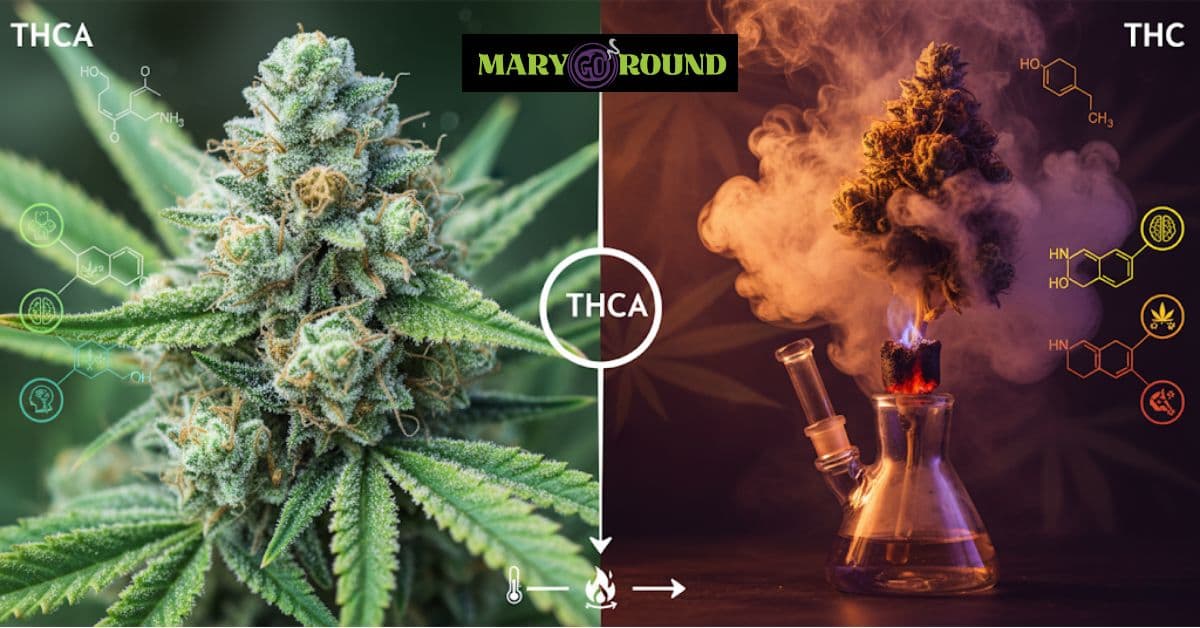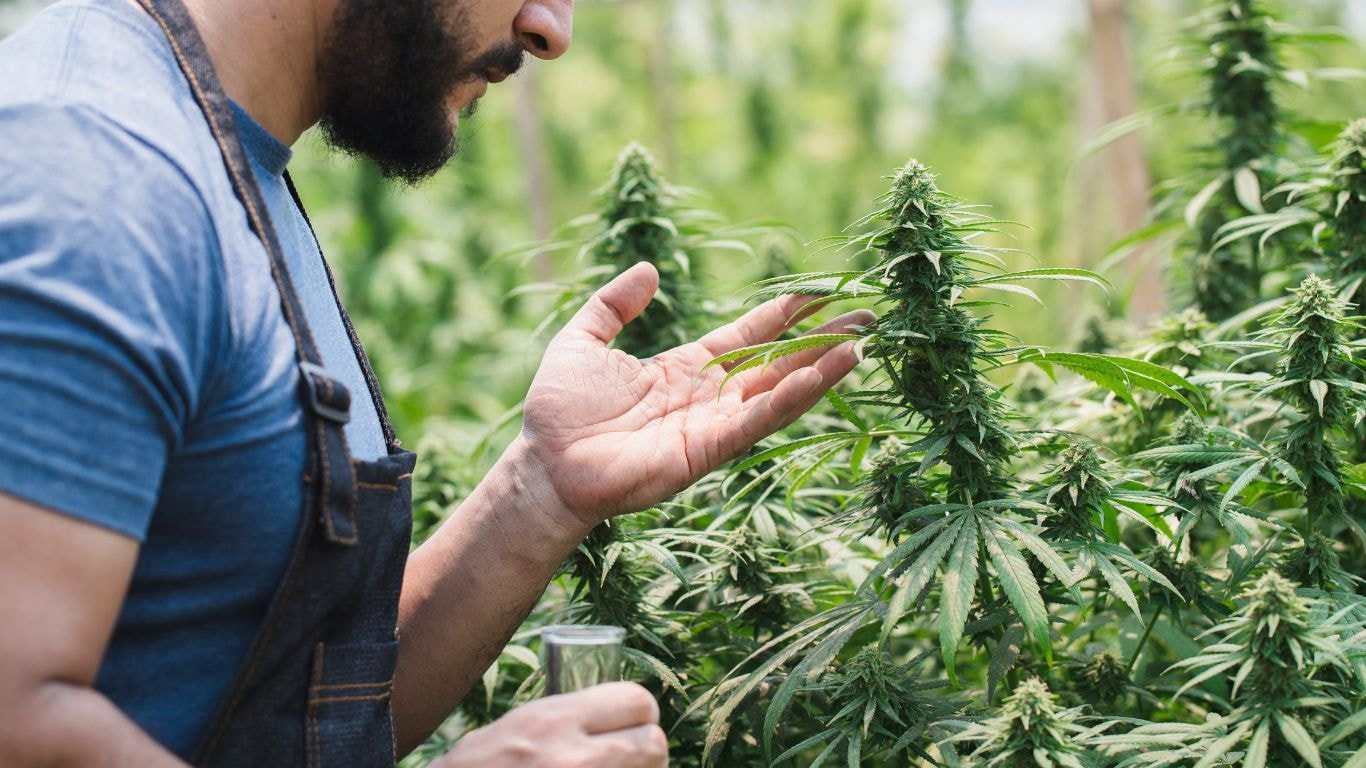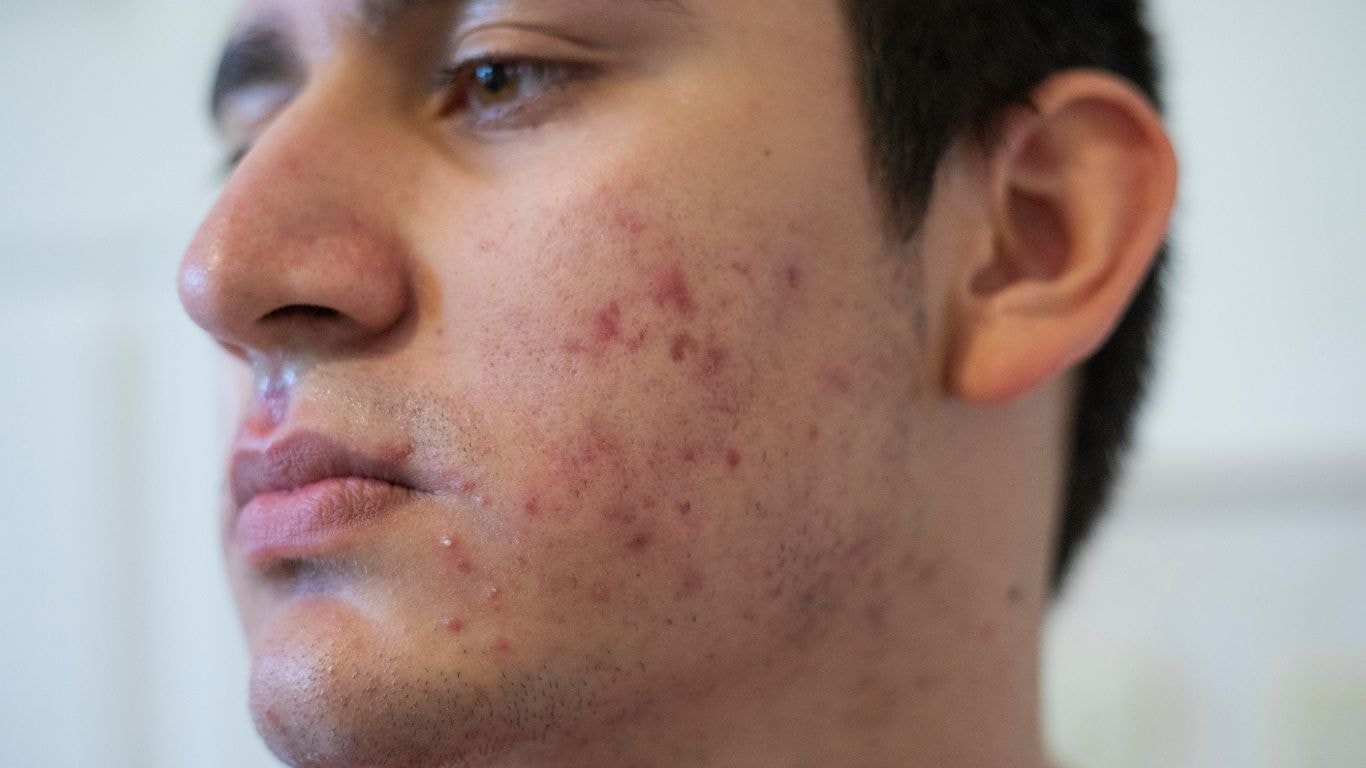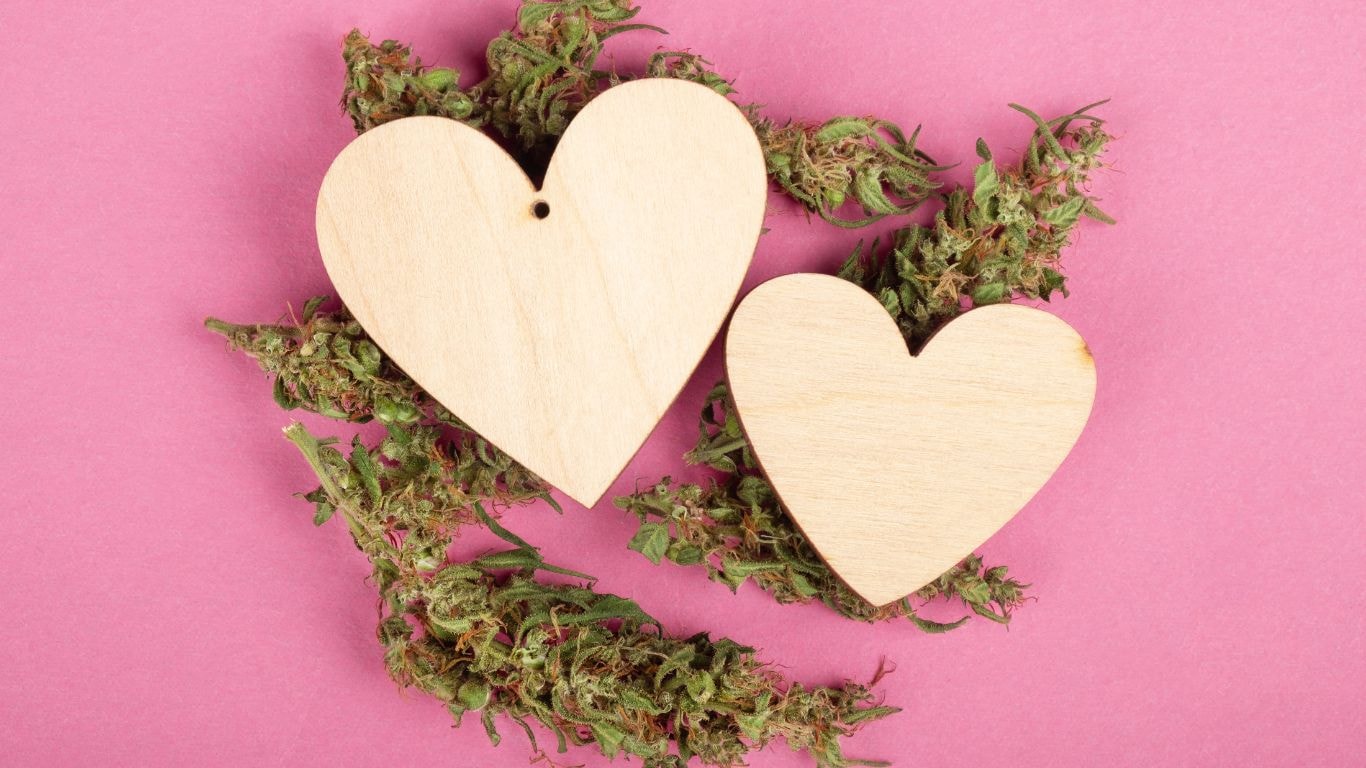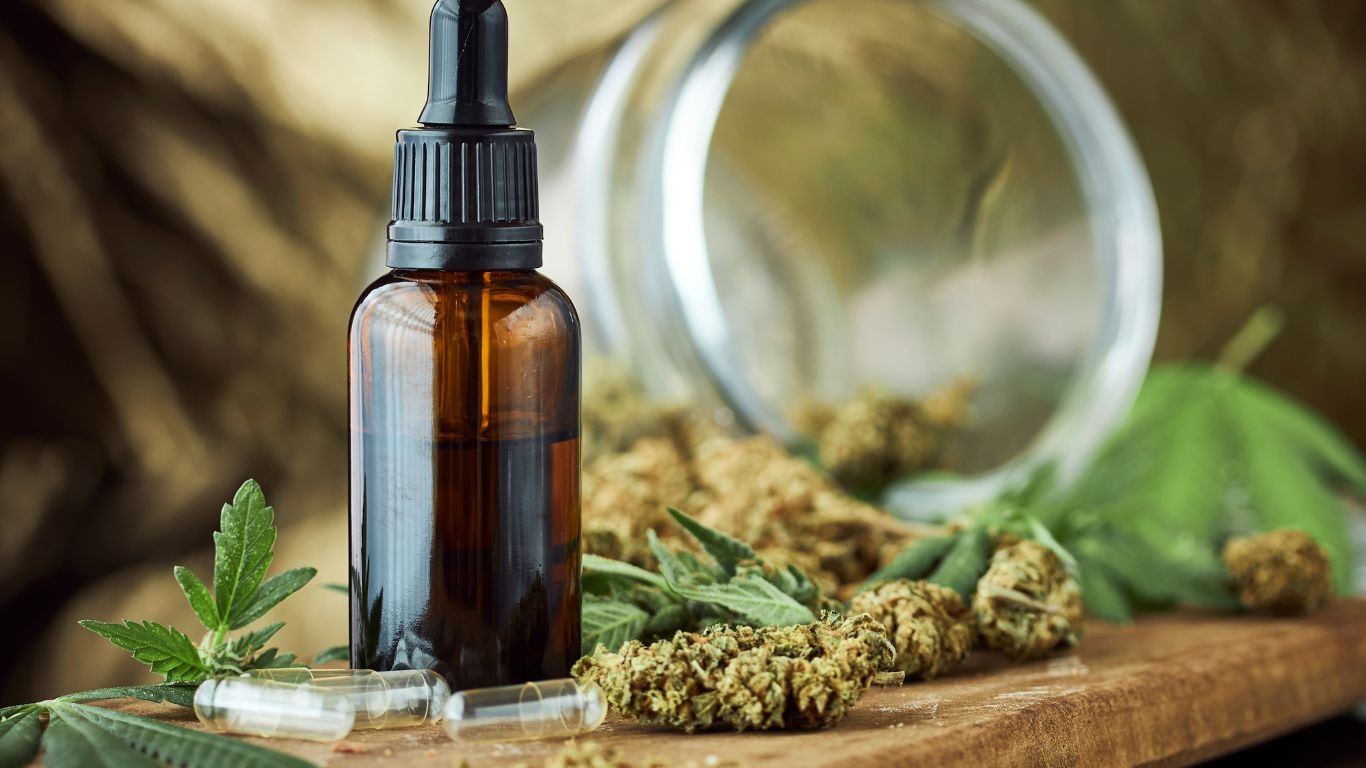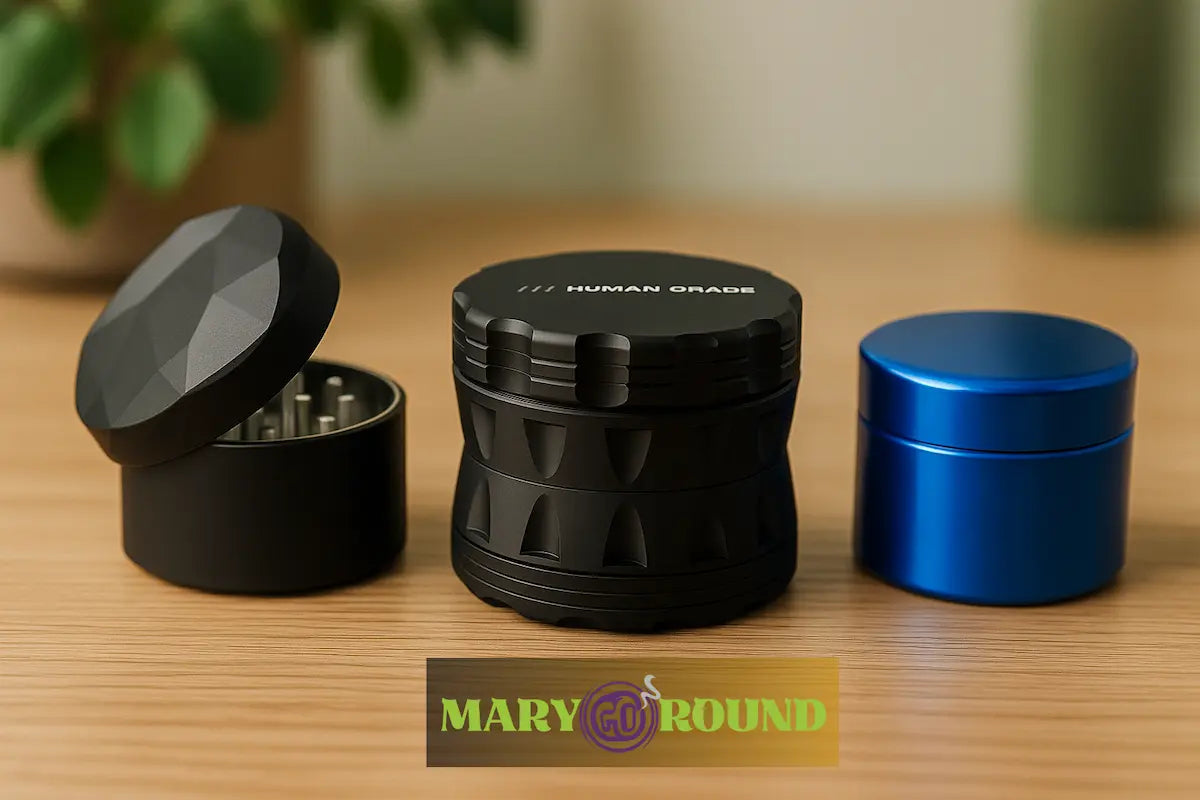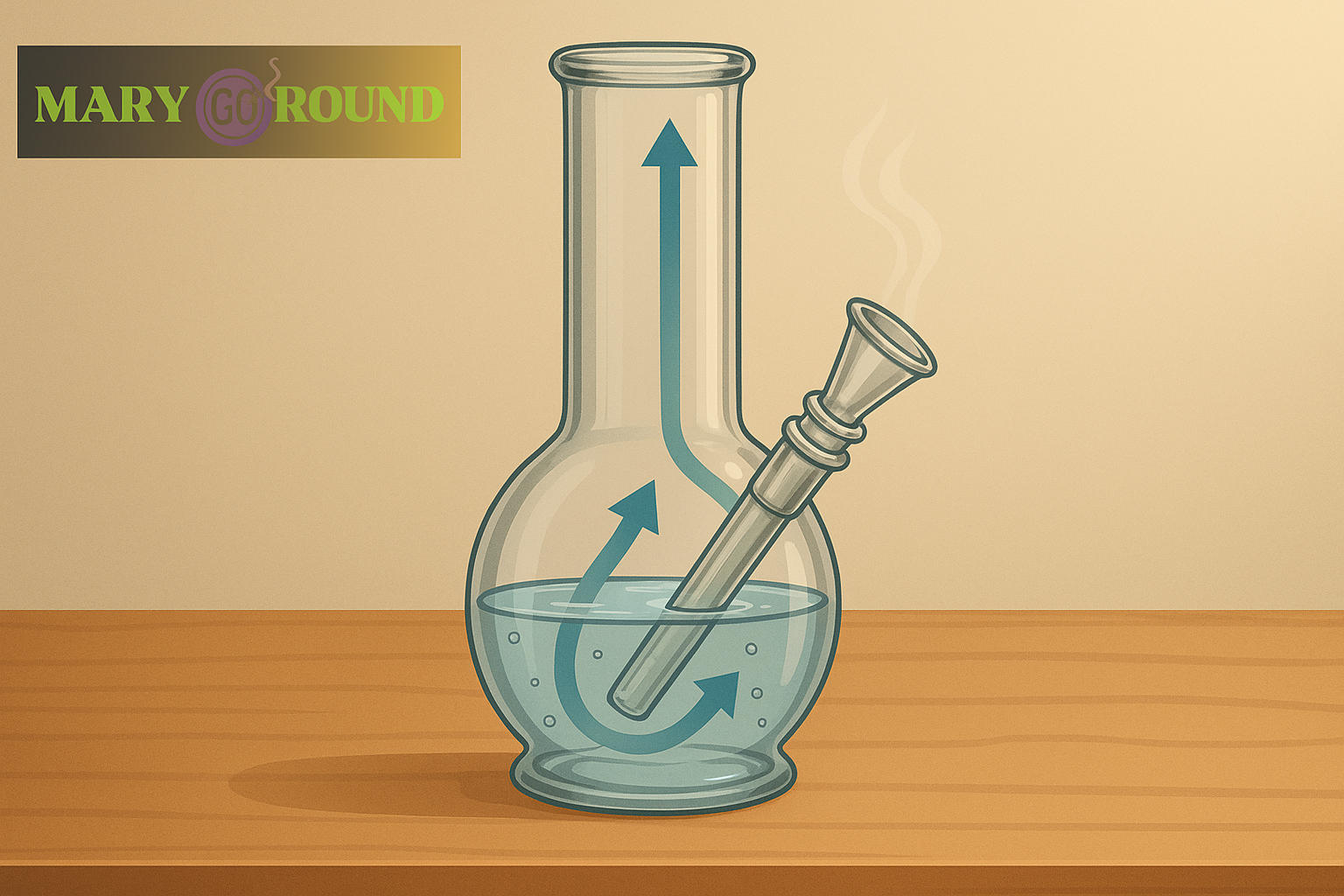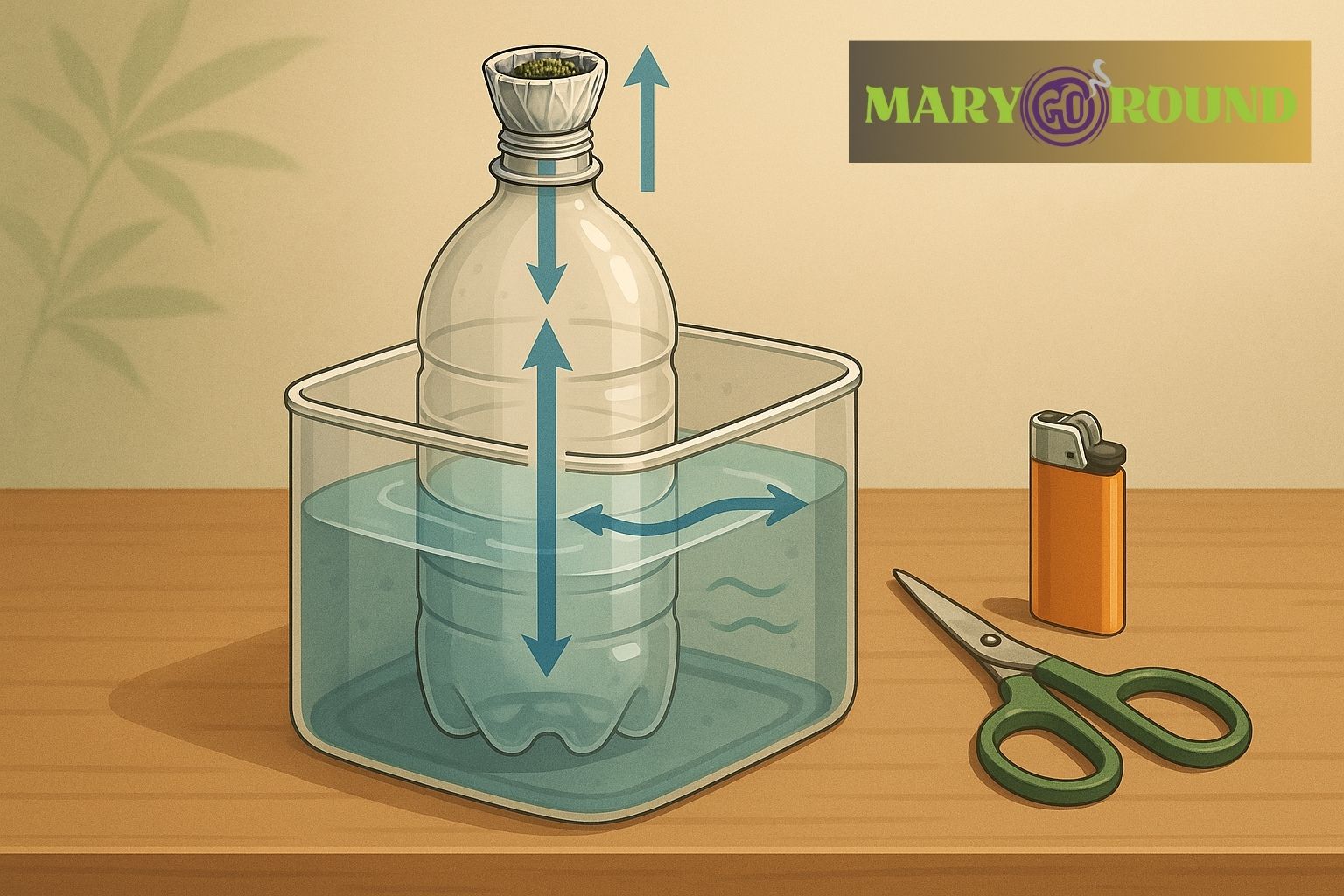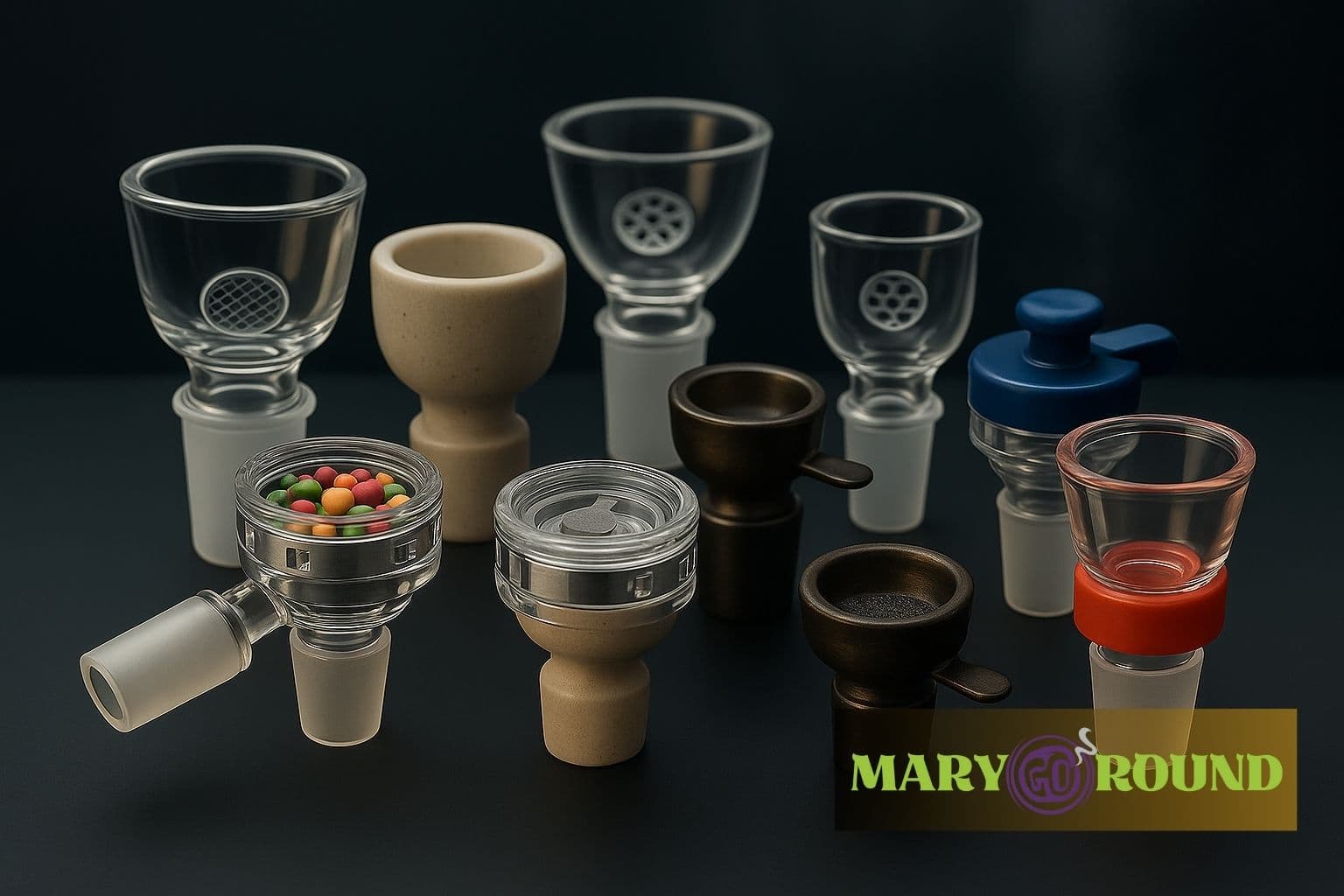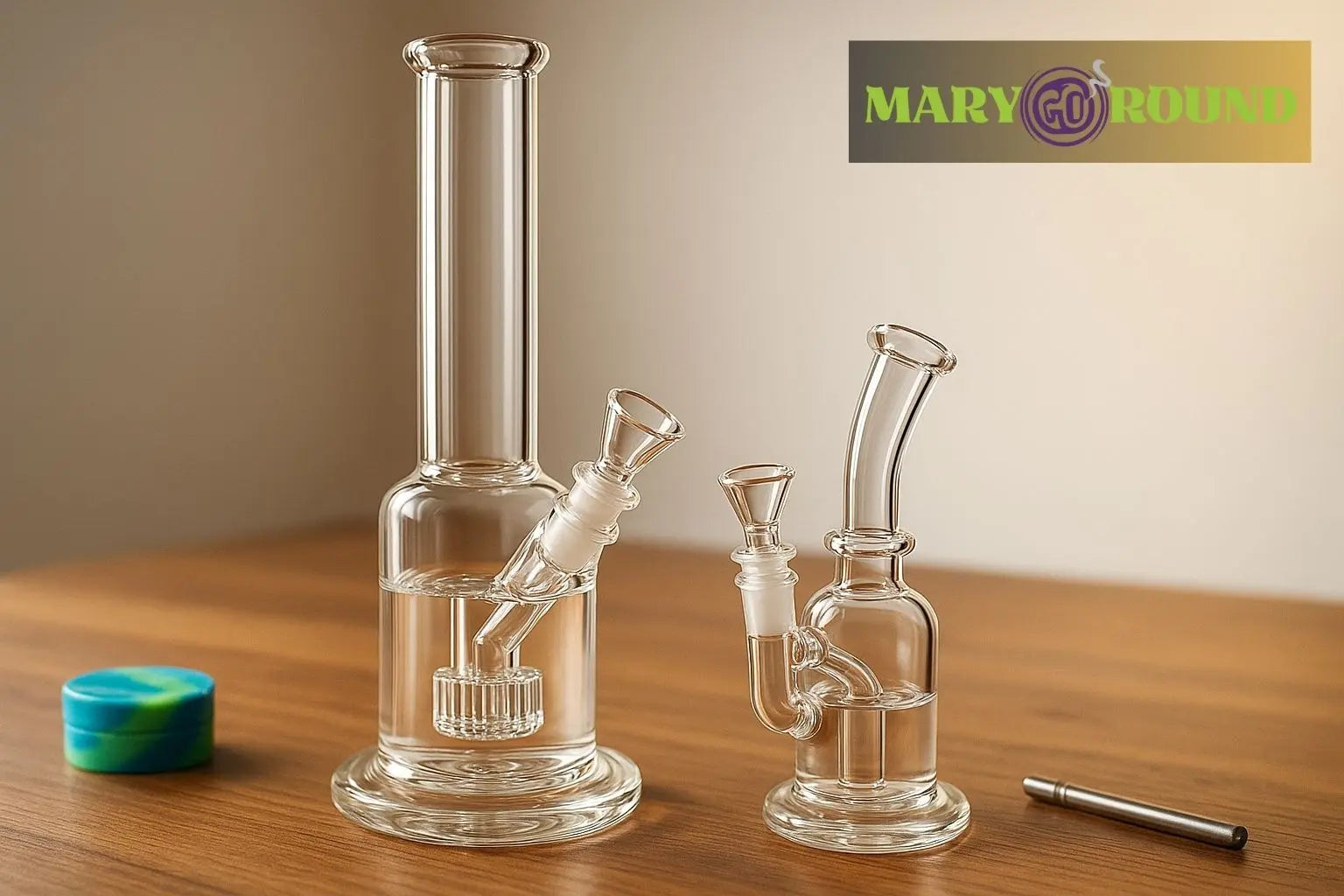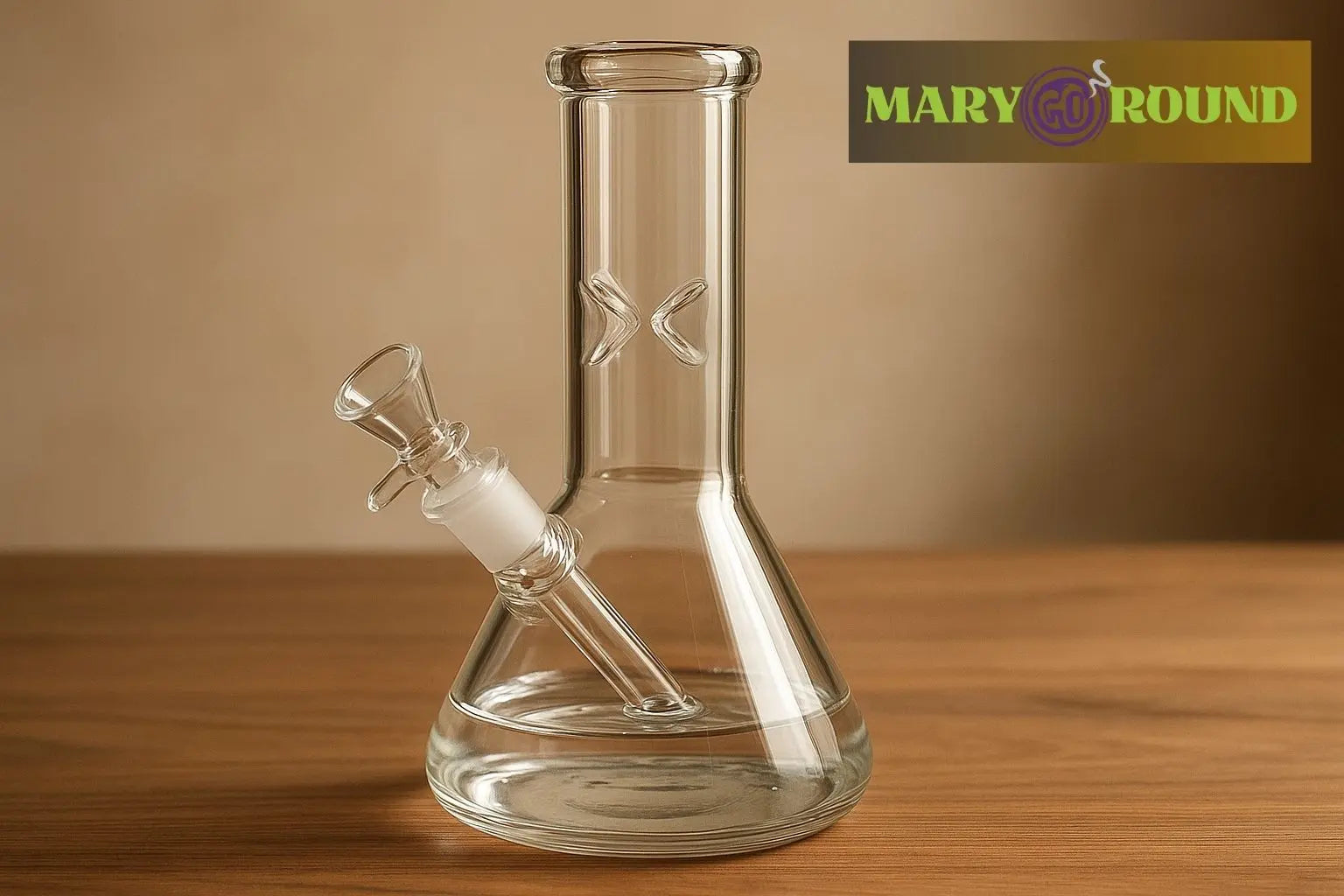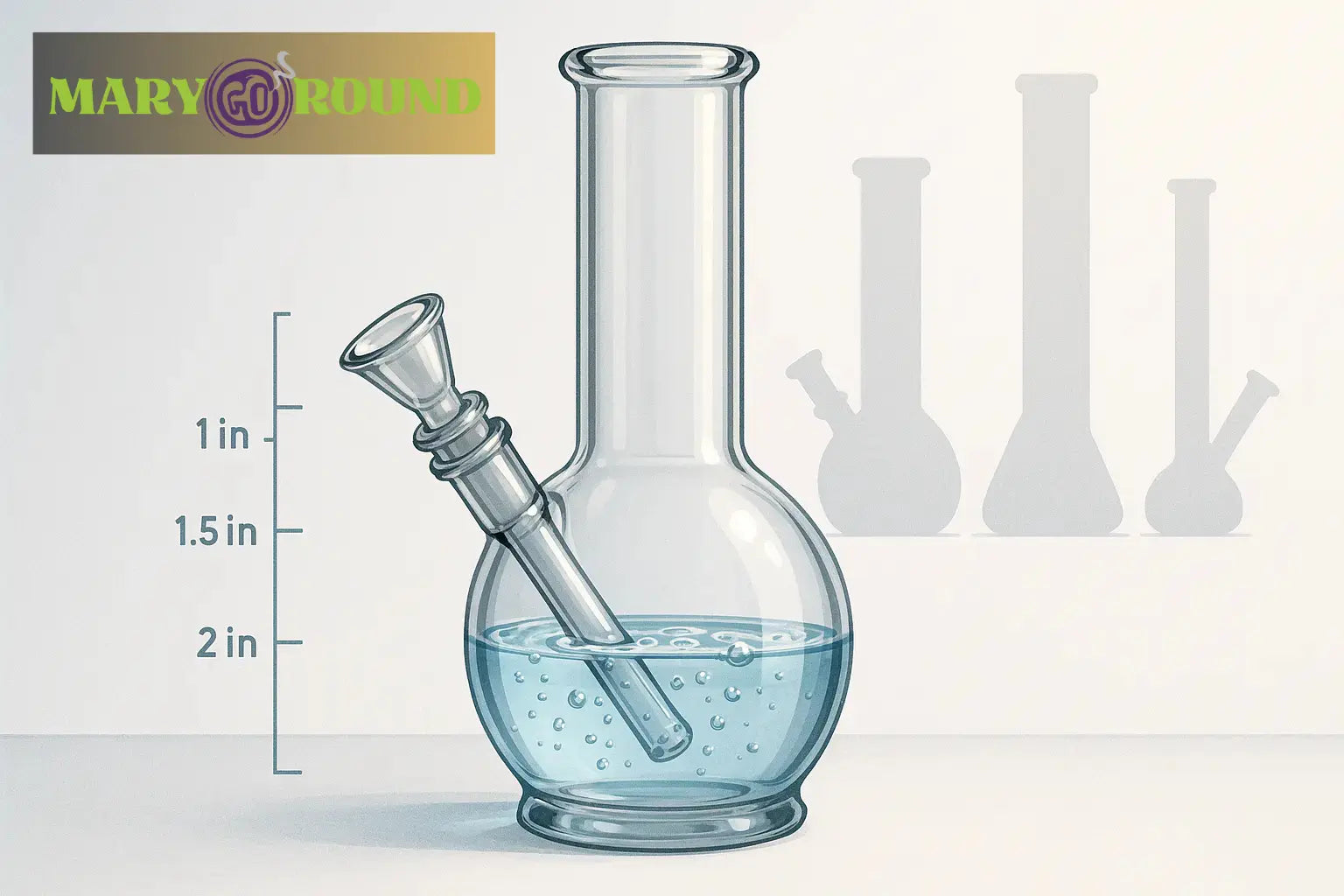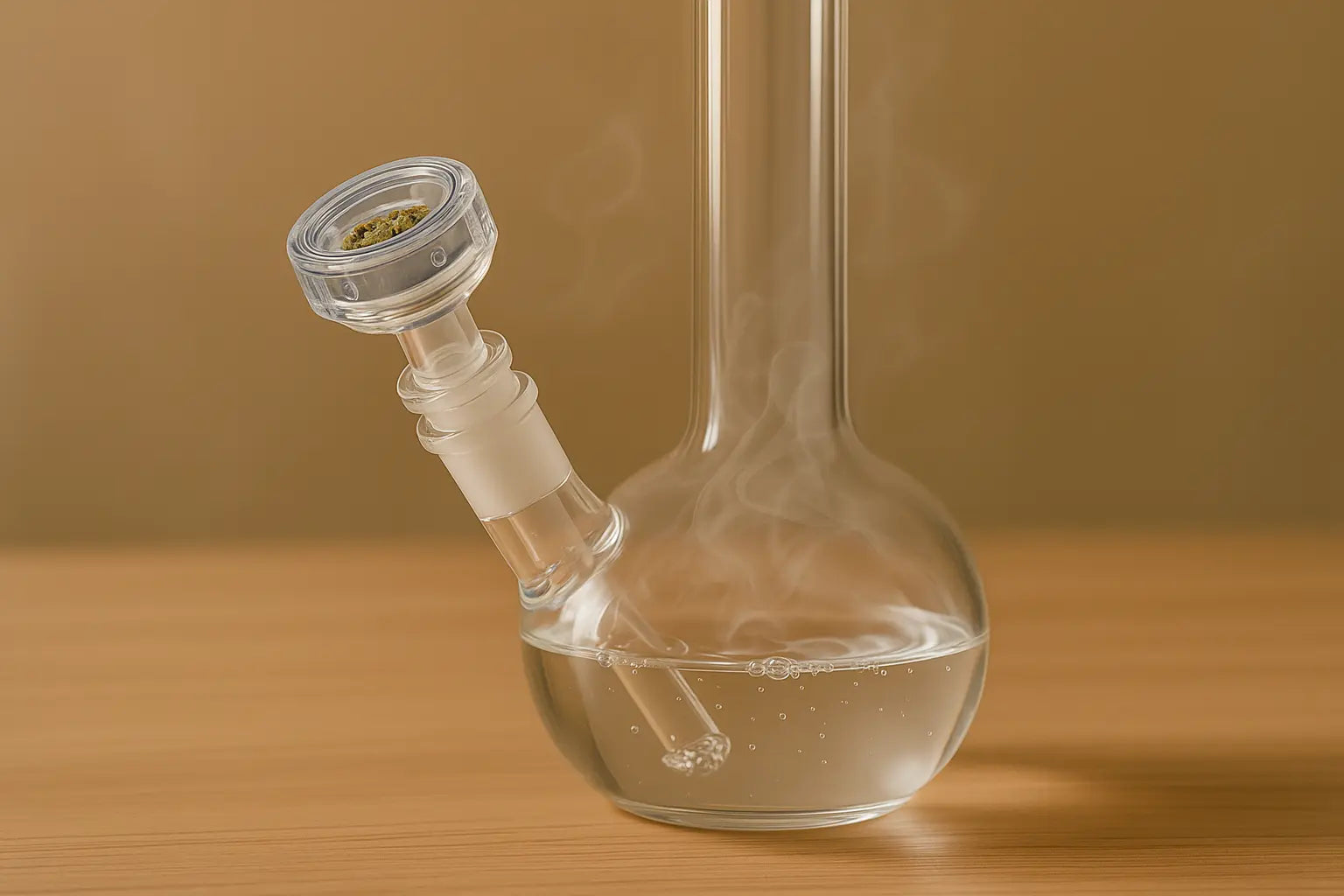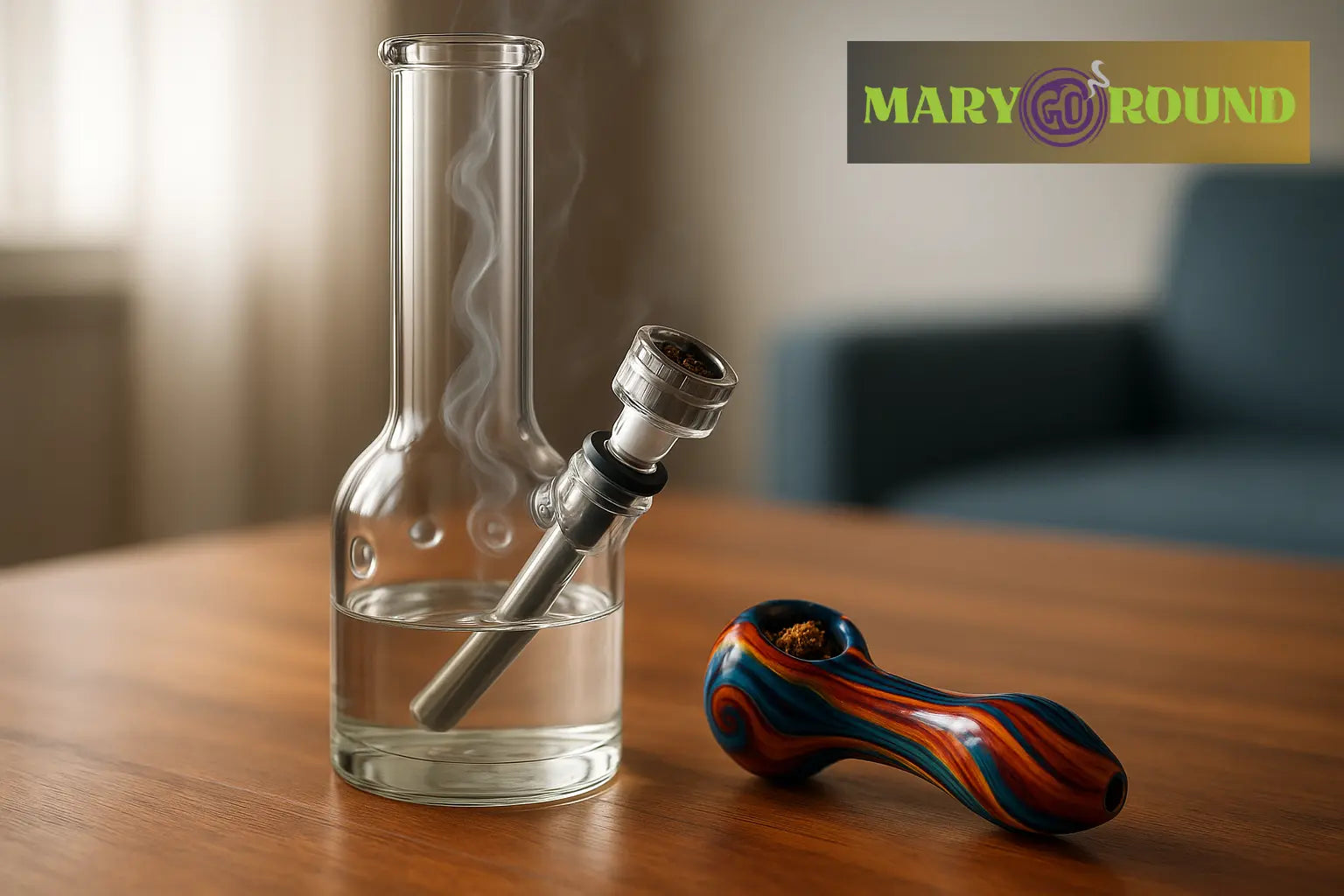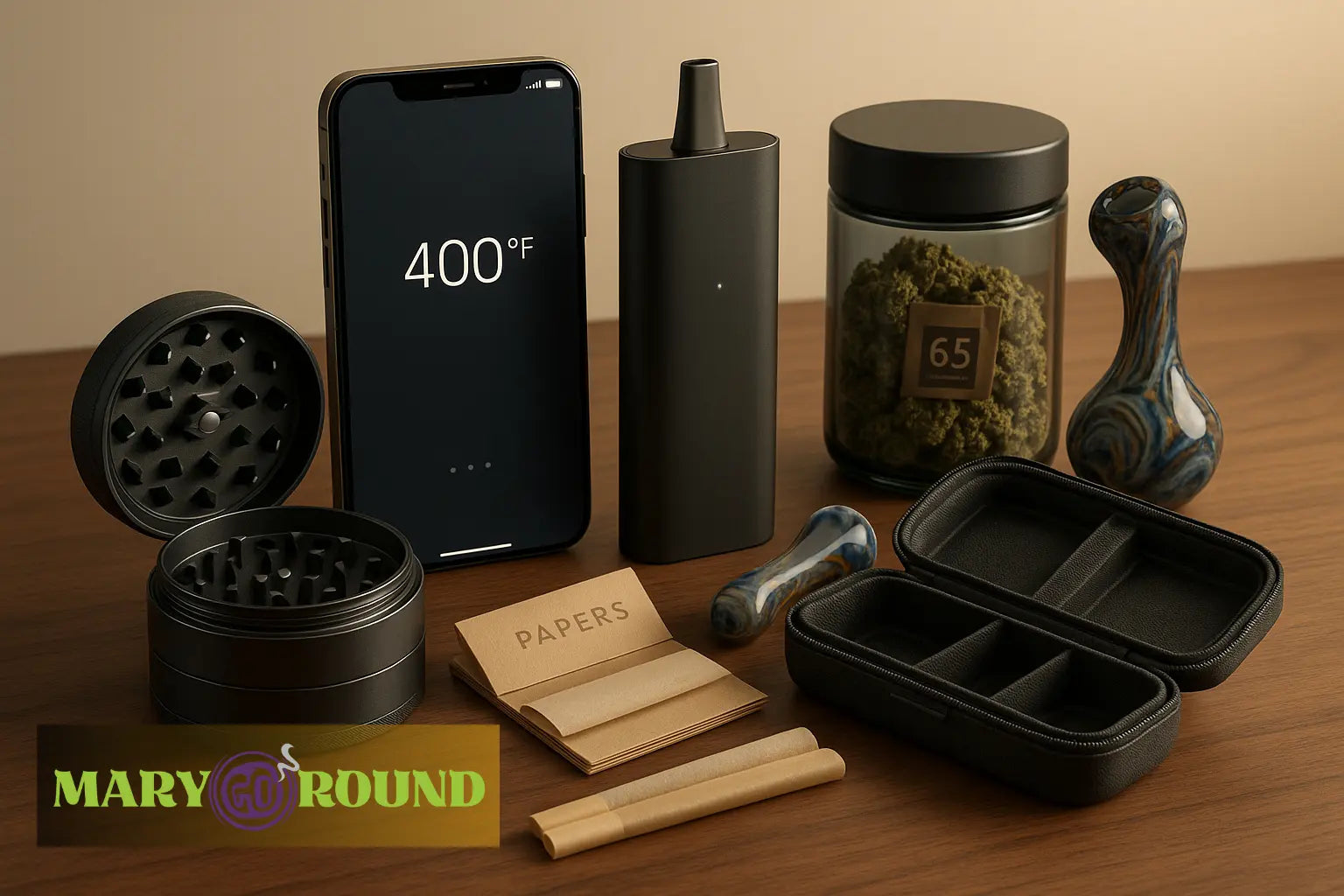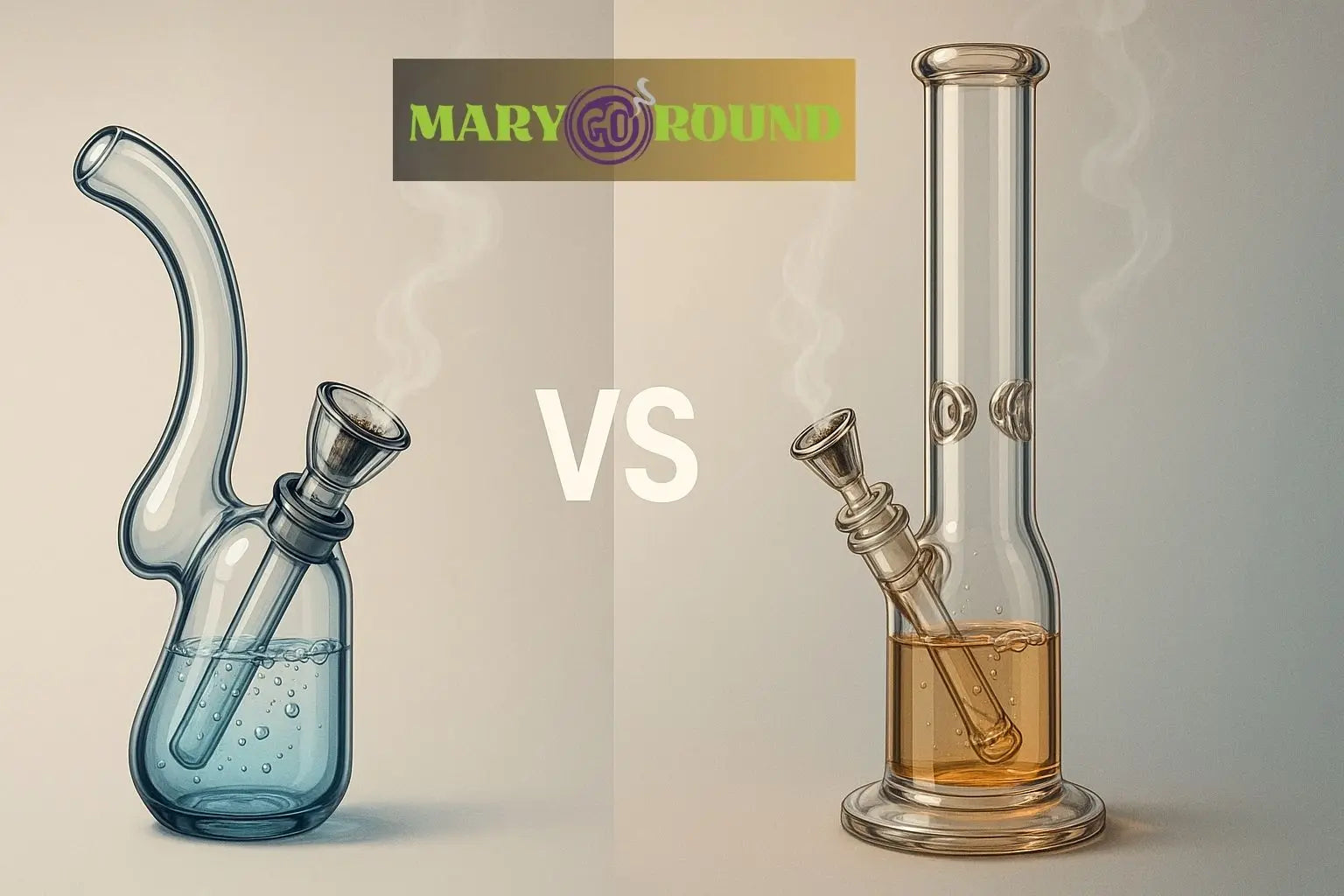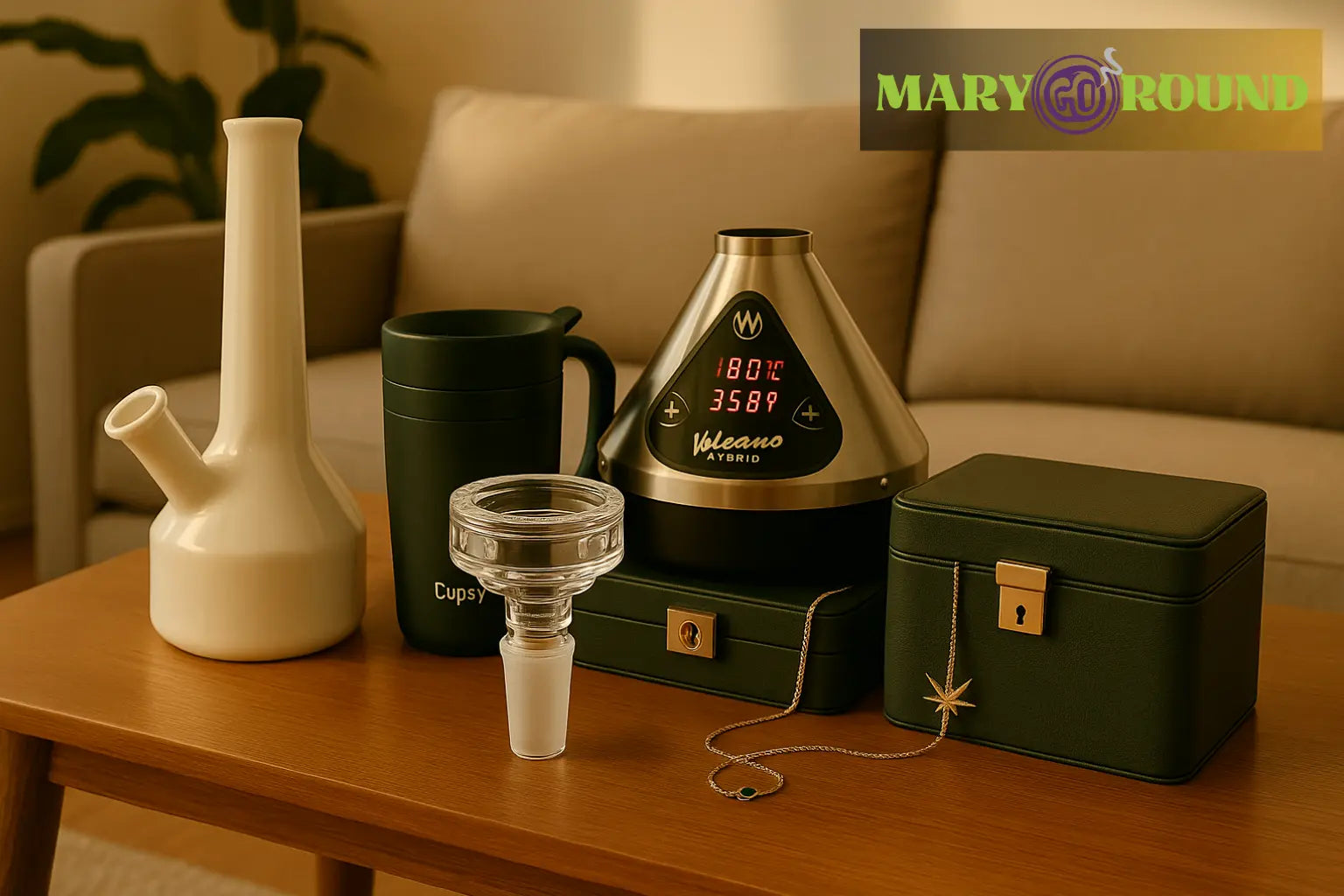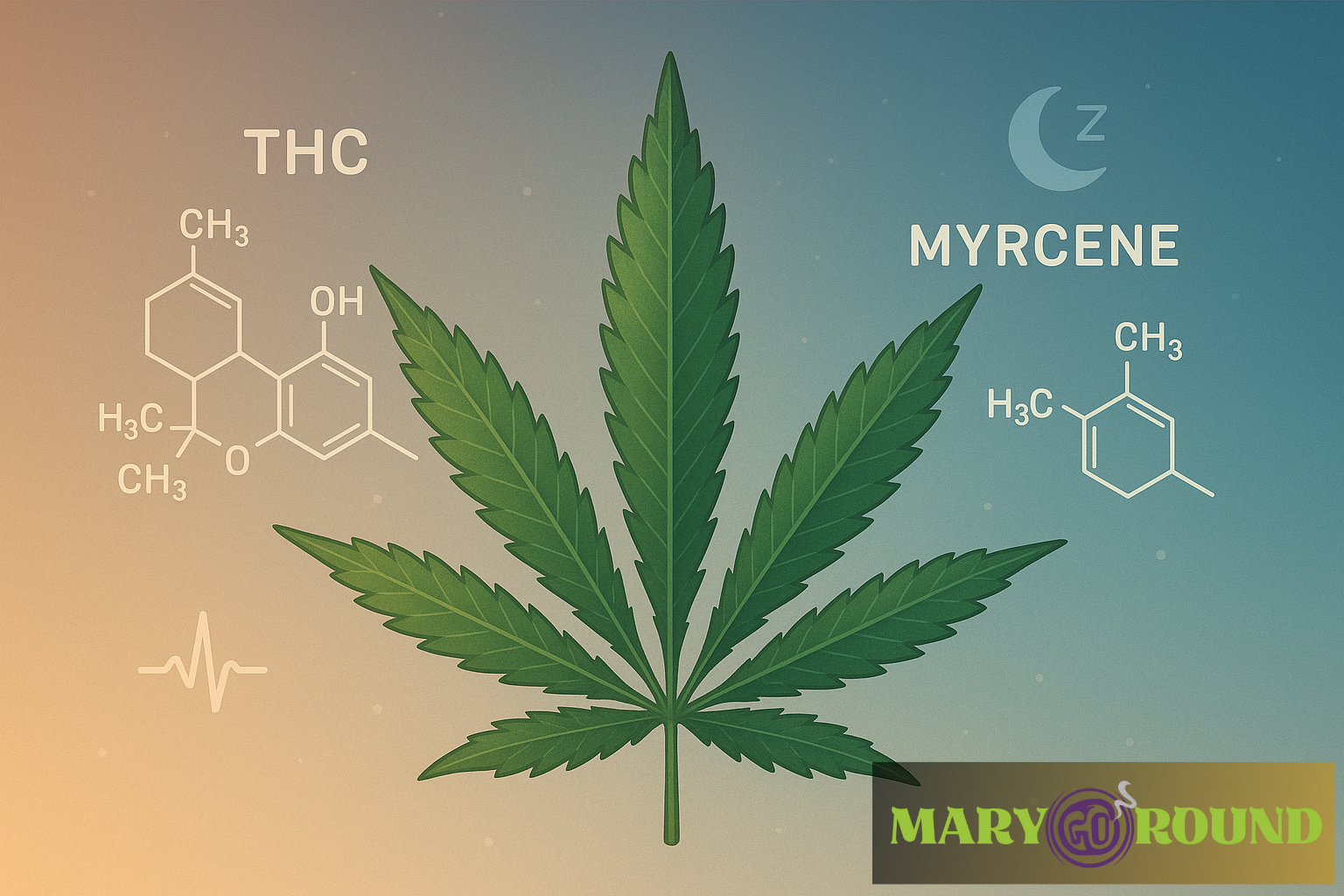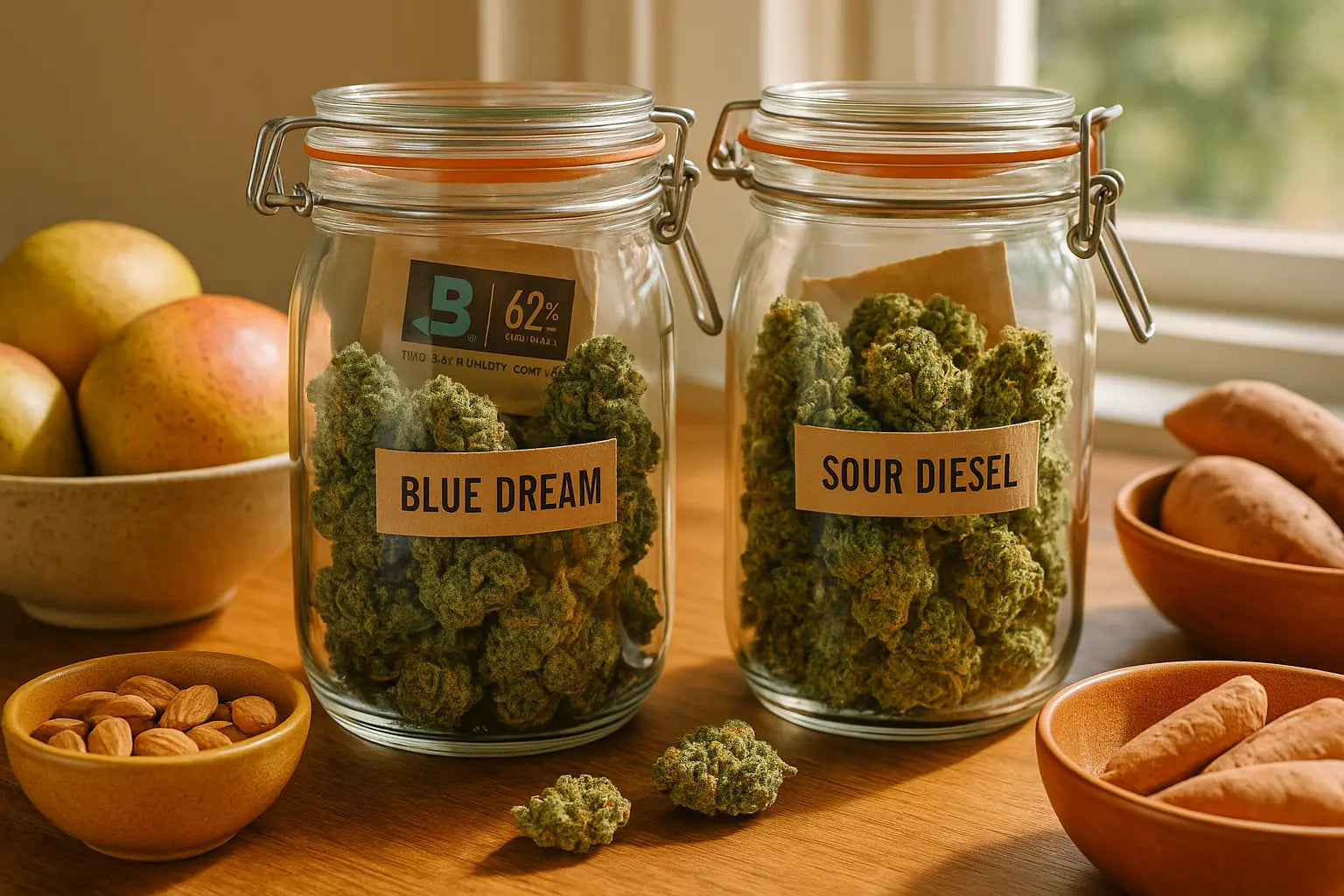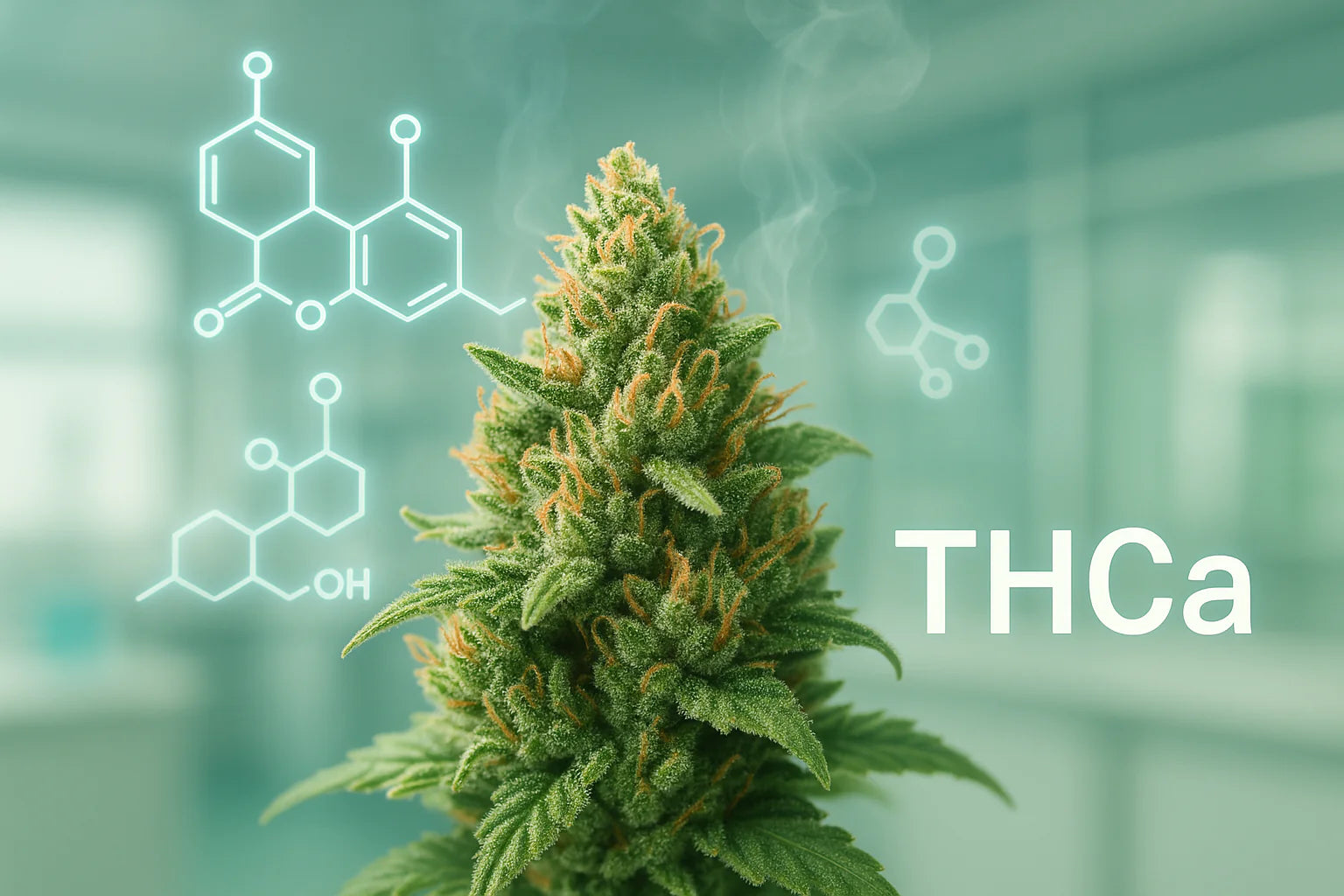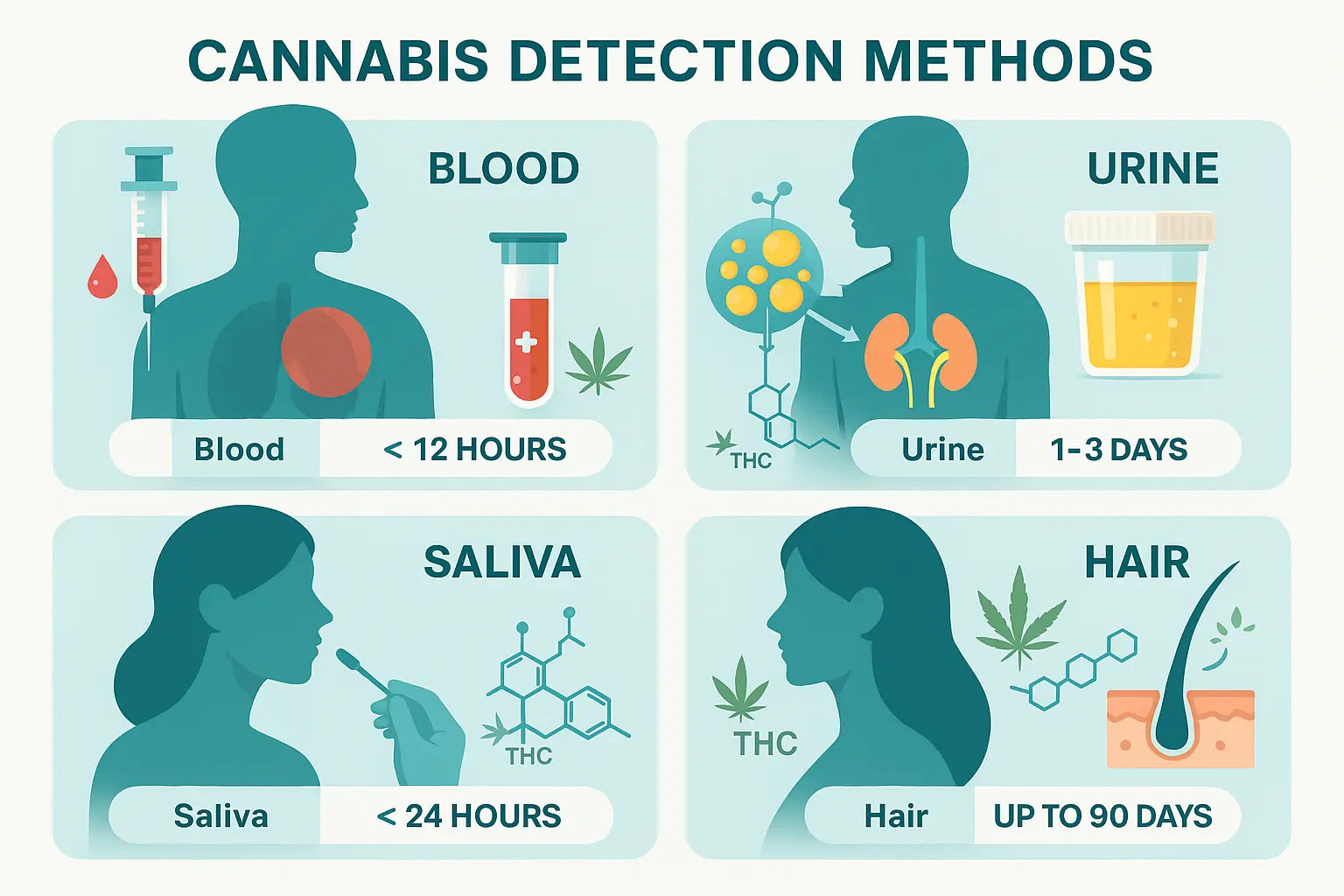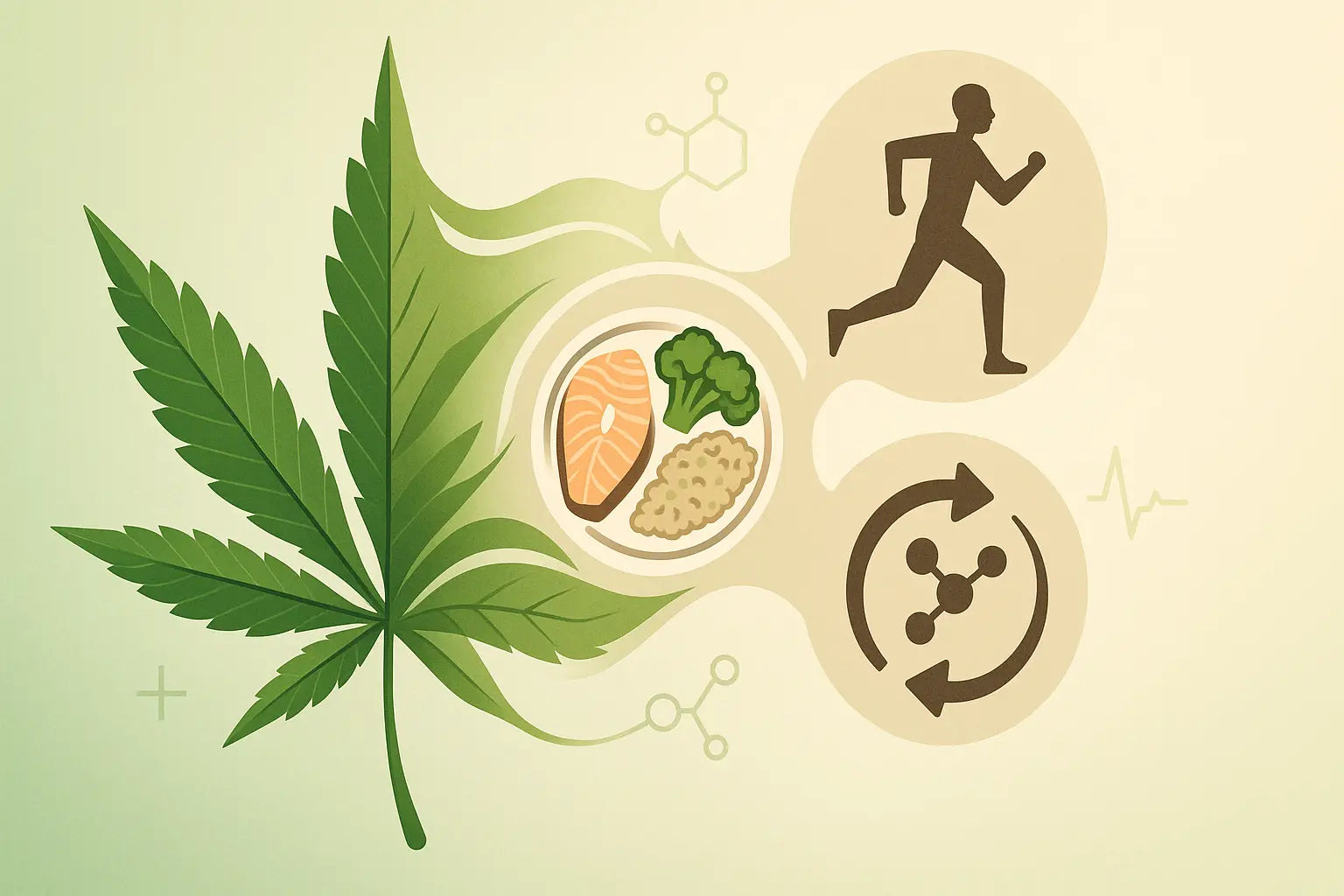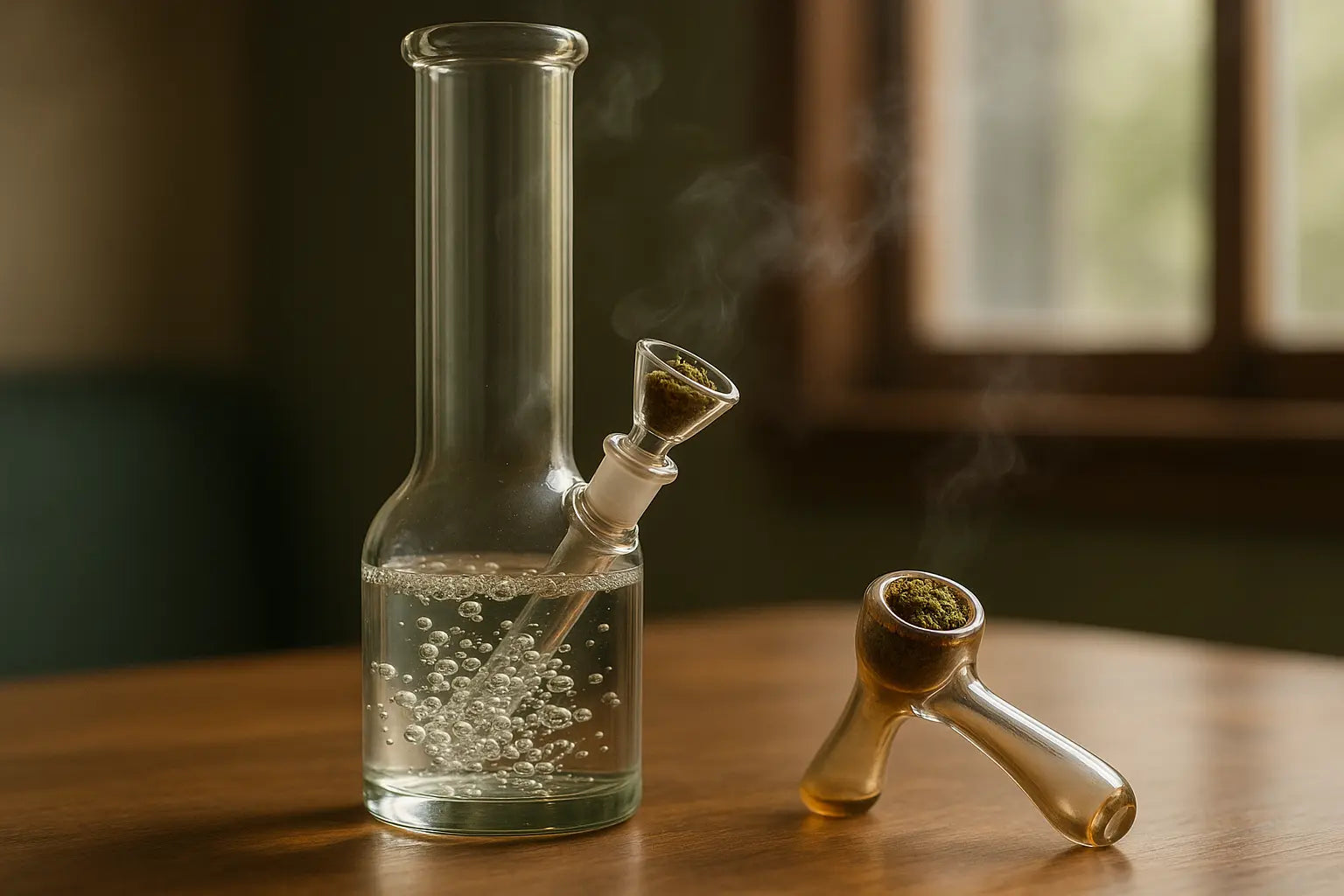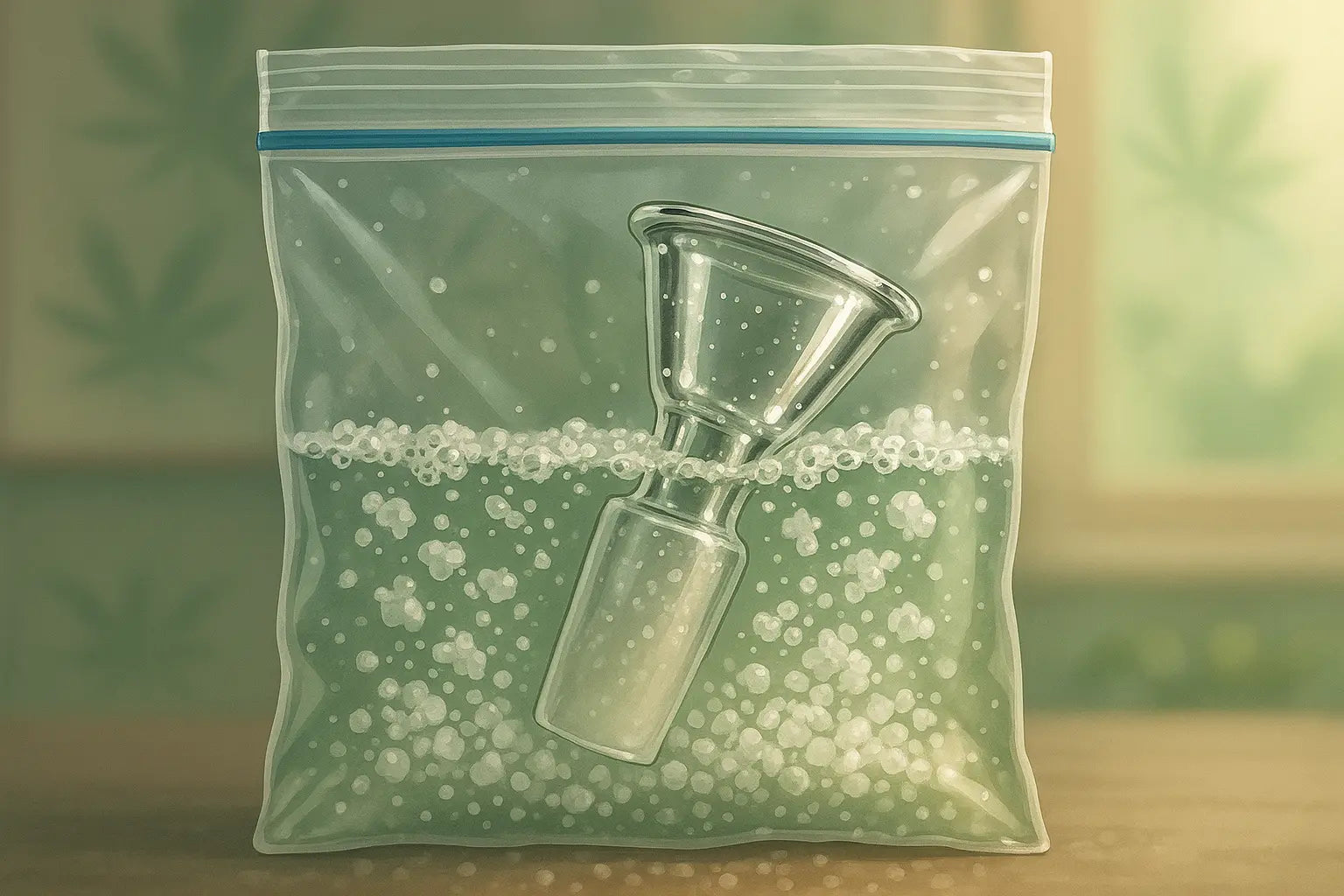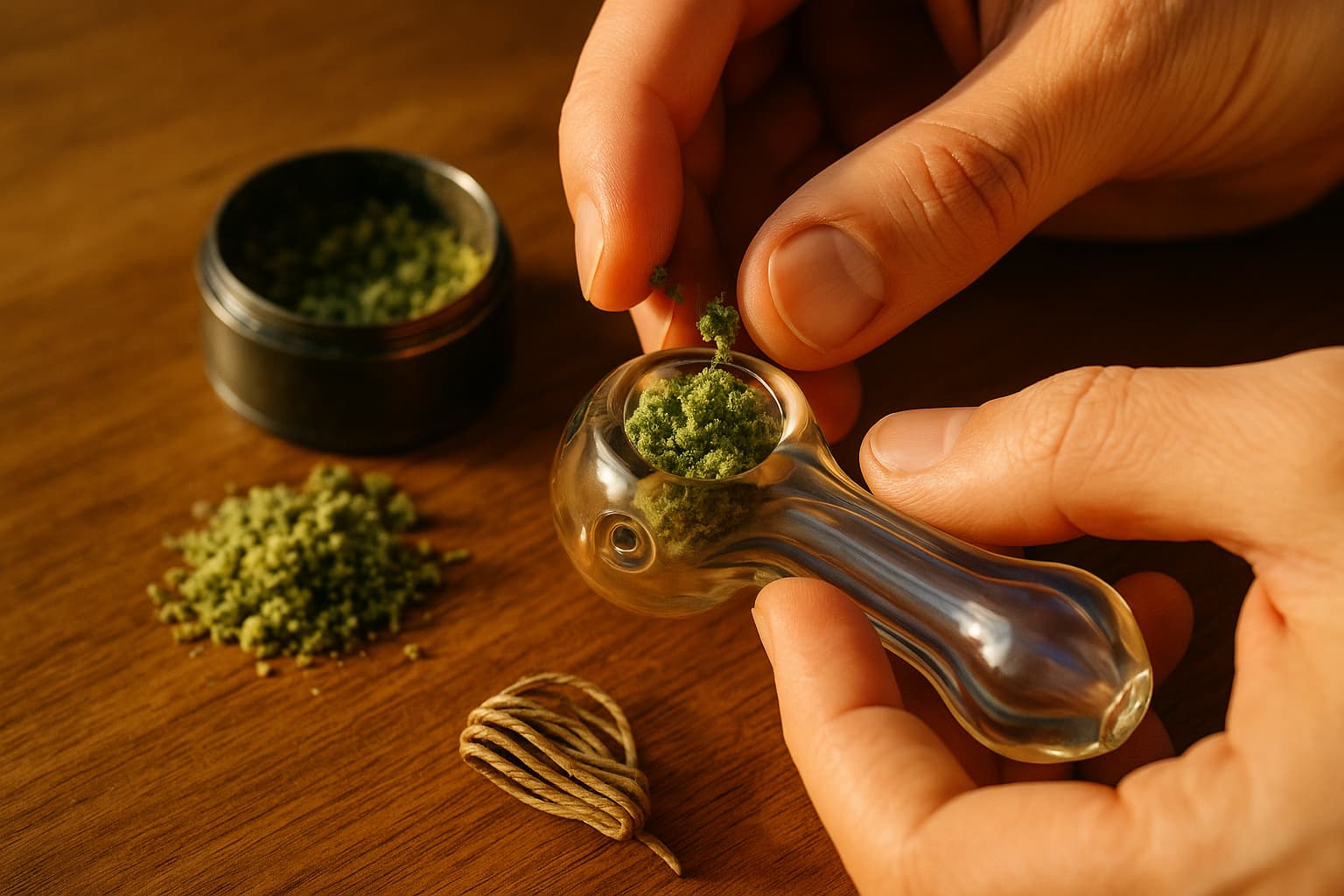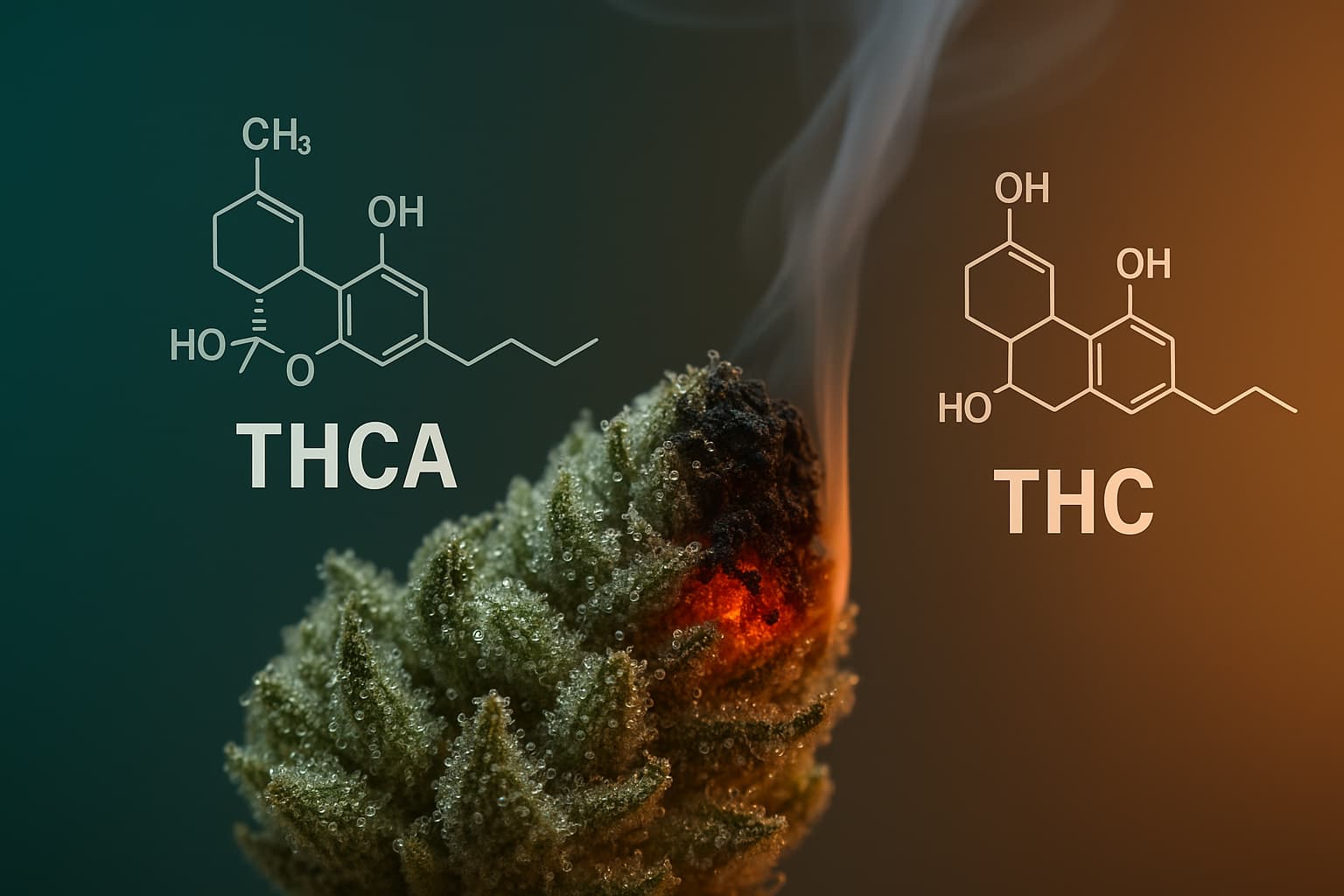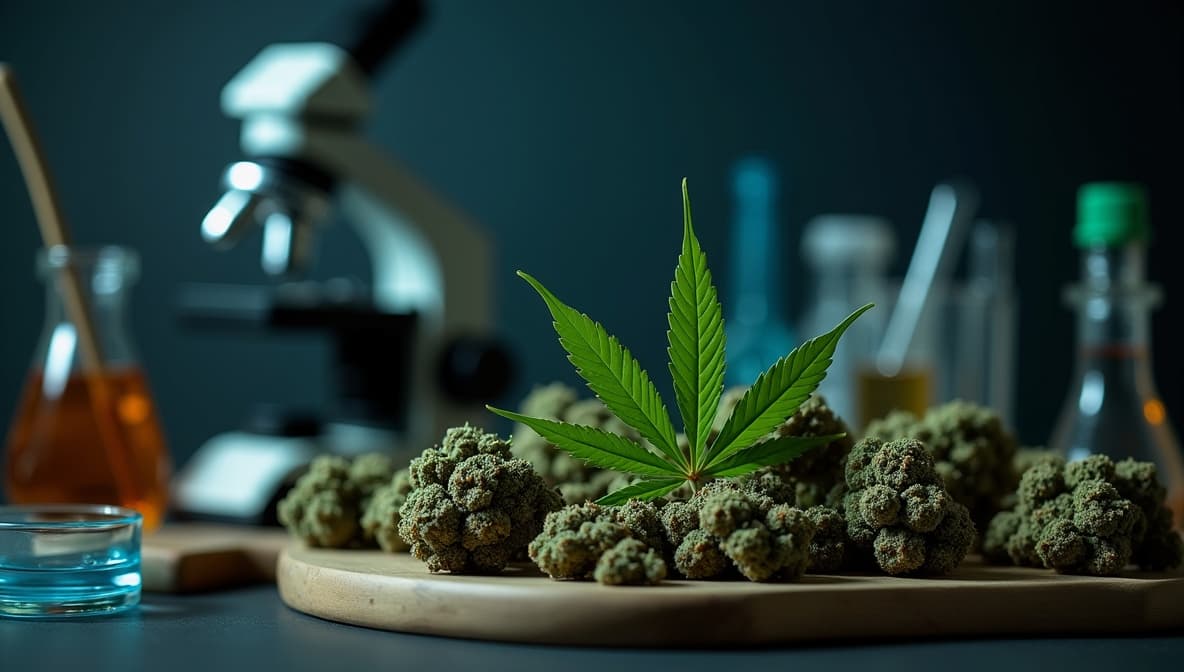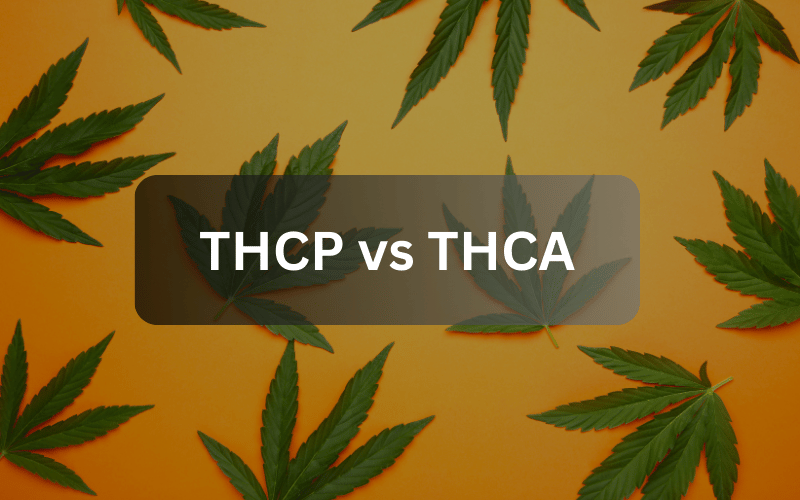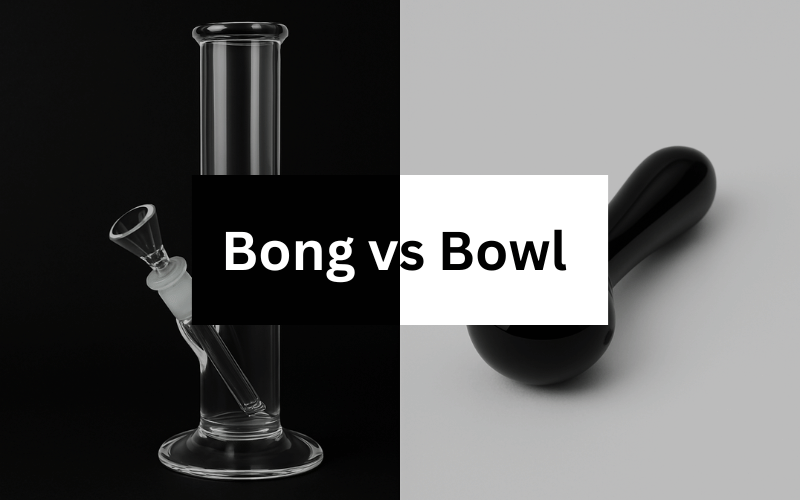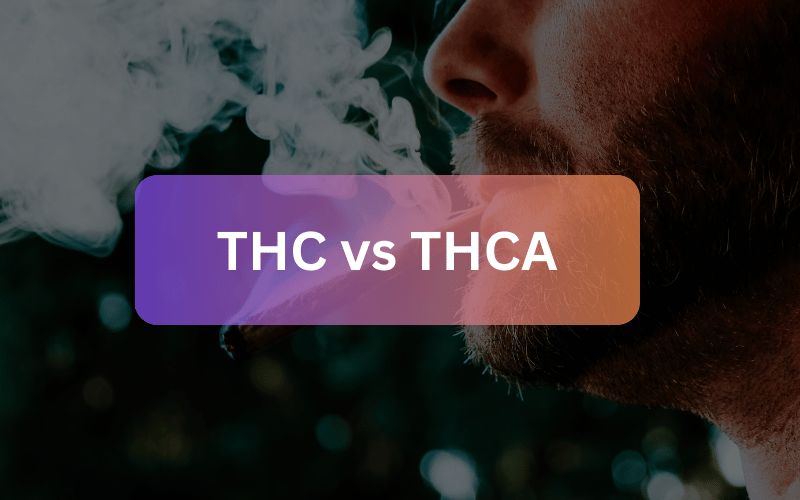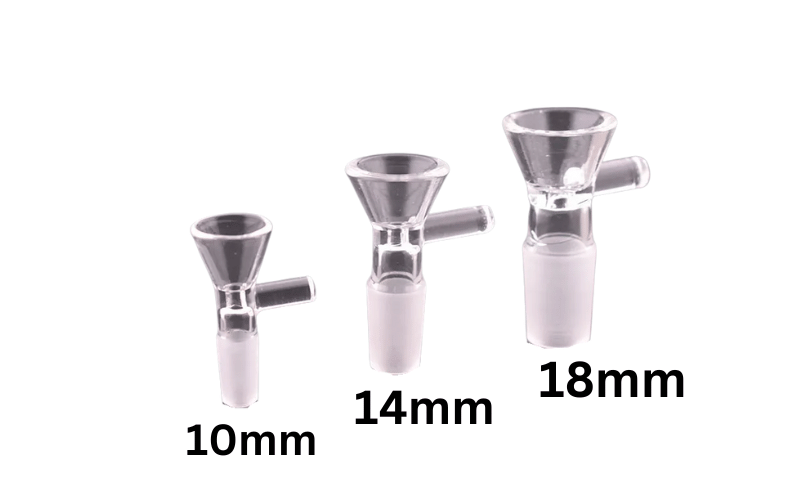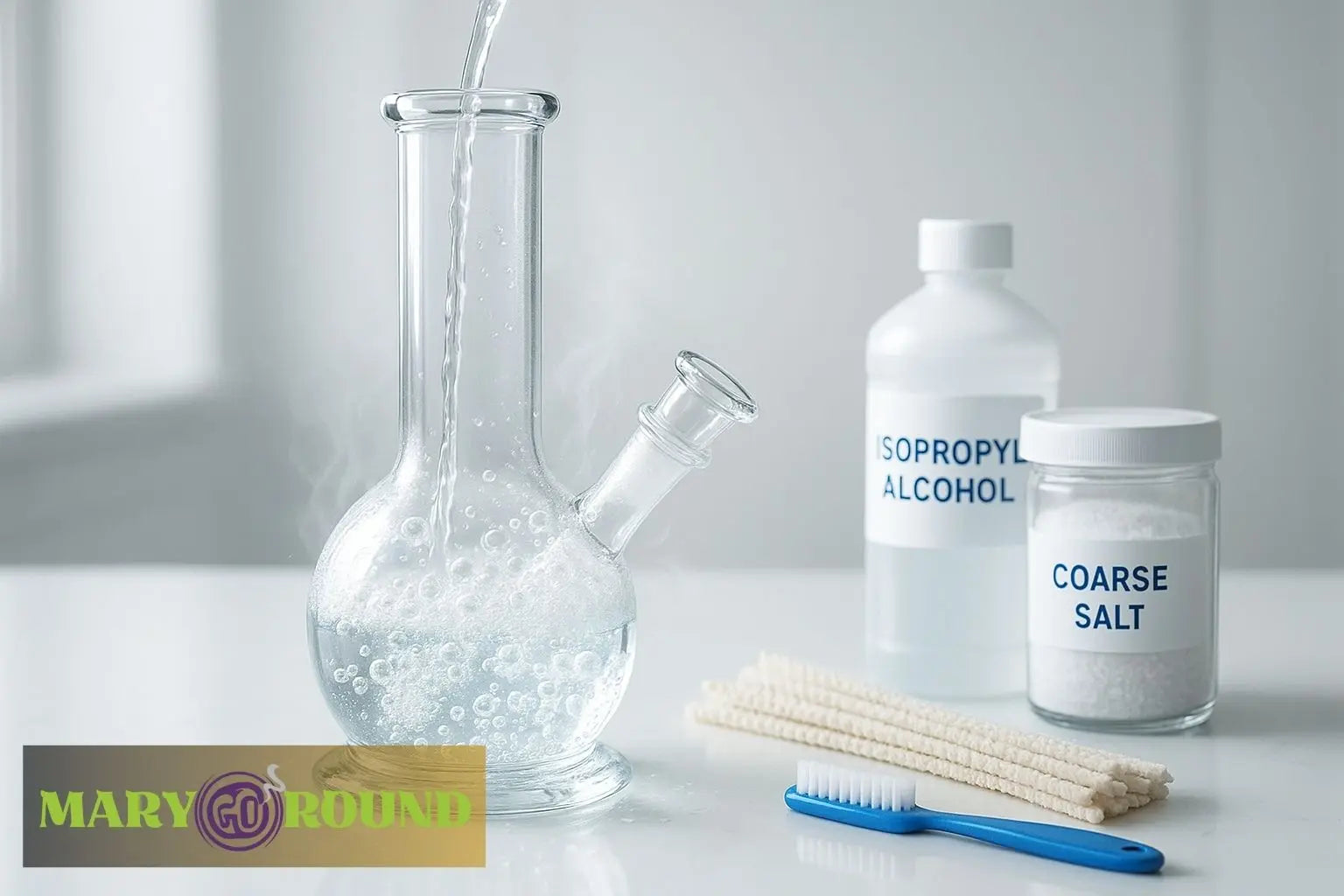
How Often Should I Clean a Bong? Essential Cleaning Tips and Advice
Posted by Tom Wittneben on
How often should I clean a bong? If you use it daily, change the water after each session and deep clean weekly. Moderate users should change the water every 2-3 days and deep clean every 1-2 weeks.
Occasional users should never leave water sitting for more than 24 hours and clean thoroughly after each use. Most users should clean their bongs every few days at maximum if they use them frequently.
Keep reading for detailed cleaning tips and advice on how often you should clean a bong.
Key Takeaways
-
Change bong water after each use to maintain hygiene, prevent residue buildup, and enhance smoke flavor.
-
Daily and moderate users should perform deep cleans regularly, while occasional users must avoid leaving water stagnant for over 24 hours.
-
Regular inspections and proper storage are essential to prevent mold growth and ensure a safe smoking experience.
Determining How Often to Clean Your Bong
The frequency of cleaning your bong hinges on a few key factors: personal preference for cleanliness, frequency of use, and the type of material your bong is made from. A good rule of thumb is to change bong water after each use to maintain optimal functionality and hygiene.
Factors affecting cleaning frequency include how dirty the bong gets, how many users there are, and personal preferences. Regular water changes improve filtration, prevent residue buildup, and enhance the flavor of your smoke. While some users may prefer a spotless bong for every session, others might be content with less frequent cleaning.
Even a seasoned smoker should not neglect regular cleaning to maintain optimal flavor and safety. Ultimately, maintaining a clean bong ensures it functions properly and provides a pleasant smoking experience.
Consistency in proper cleaning is also crucial to prevent clogs in percolators and downstems, which can significantly impact airflow and overall enjoyment. If you frequently pull ash through the downstem, your bong will get dirty faster and require more frequent cleaning.
Adjusting your cleaning schedule based on your usage patterns and preferences will help you find the right balance with cleaning agents and a cleaning solution.
Let’s explore how different usage habits dictate the cleaning methods and frequency for your bong.
Daily Users
For daily users, maintaining a clean bong is even more critical. Recommended practices include cleaning the bong after every one to two uses to ensure optimal hygiene and performance. Others include:
-
Changing the bong water after every session to keep it fresh and free of contaminants.
-
This practice preserves the flavor of your smoke and prevents the buildup of harmful bacteria and mold.
-
Performing a deep clean at least once a week to thoroughly remove any stubborn residue and keep your bong in top condition. For deep cleaning, use a mixture of alcohol and salt to disinfect the bong and effectively remove stubborn residue, odours, and bacteria.
Cleaning Shared Bongs
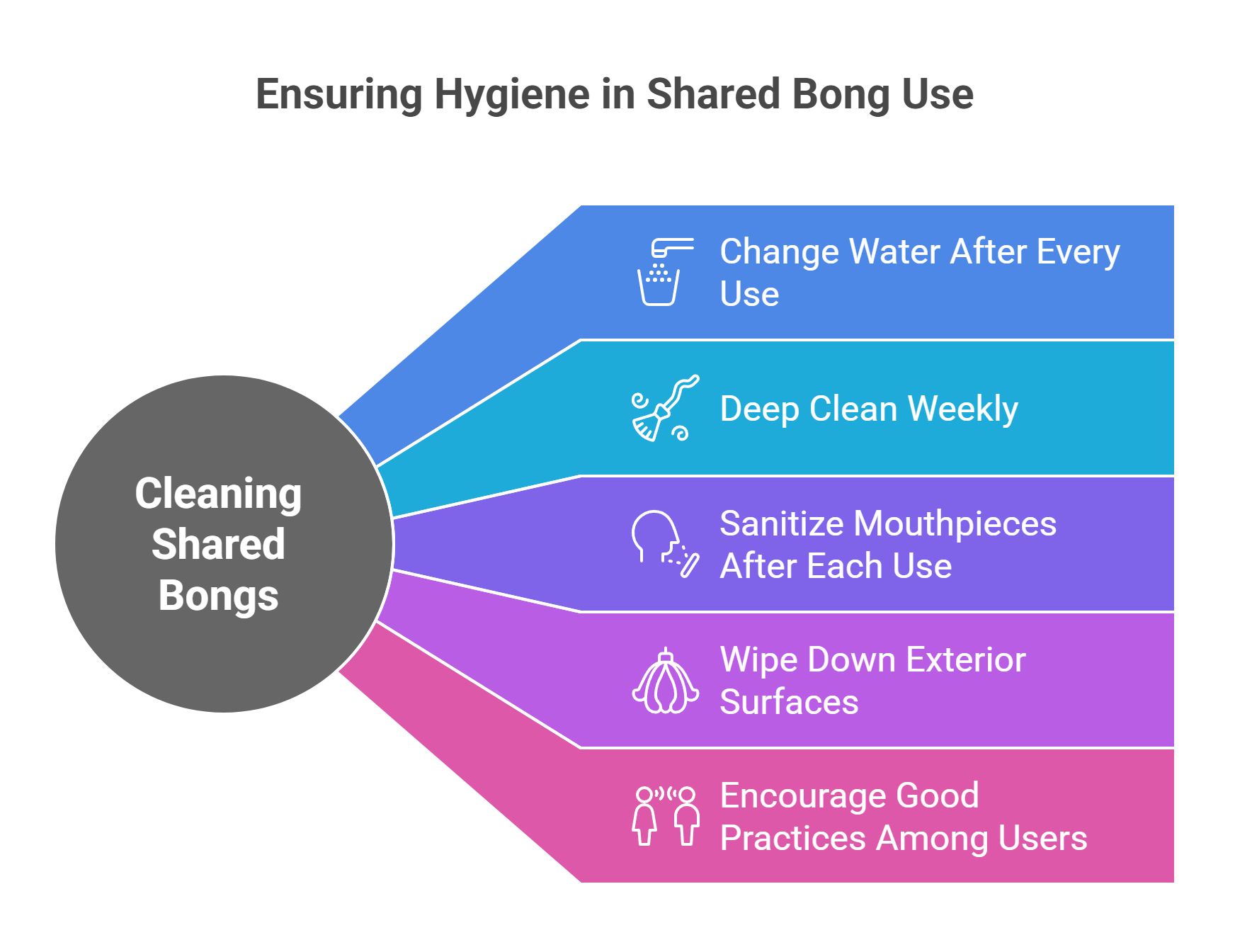
When sharing a bong with others, maintaining strict hygiene protocols is essential to prevent the spread of germs and ensure everyone enjoys a clean, safe smoking experience. Here are recommended practices specifically for shared use:
-
Change Water After Every Use: Always empty and replace the bong water after each session, especially when multiple people are using the same bong.
-
Deep Clean Weekly: Perform a thorough deep cleaning of the entire bong, including the bowl, downstem, and chambers, at least once a week if the bong is shared frequently. Use isopropyl alcohol combined with coarse salt or a commercial cleaning solution to disinfect and remove stubborn resin buildup.
-
Sanitize Mouthpieces After Each Use: Use alcohol wipes or disposable sanitizing wipes to clean the mouthpiece between users. If possible, use individual mouthpieces or personal attachments to minimize direct contact and improve hygiene.
-
Wipe Down Exterior Surfaces: Regularly clean external parts that are handled, such as the base and neck, with disinfectant wipes to reduce surface contamination.
-
Encourage Good Practices Among Users: Remind all participants to avoid sharing saliva directly and to use personal mouthpieces or tips when possible to reduce cross-contamination.
Following these shared bong hygiene protocols not only reduces health risks but also helps maintain the bong’s condition and improves everyone’s smoking experience.
Moderate Users
Moderate users, who may not use their bong every day, should still adhere to a regular cleaning schedule. Changing the bong water every 2-3 days helps maintain optimal performance and ensures that each session is smooth and enjoyable.
Deep cleaning your bong every 1-2 weeks will prevent the buildup of resin and other residues that can affect the quality of your smoke. These guidelines help moderate users keep their bong clean without excessive effort.
Occasional Users
Occasional users might be tempted to let cleaning slide, but regular maintenance is still essential. Never leave bong water sitting for more than 24 hours, as stagnant water can become a breeding ground for bacteria and mold.
After each use, a thorough deep clean is recommended to remove any remaining residue and ensure the bong is ready for the next session.
These practices help occasional users enjoy a safe and hygienic smoking experience during their smoking session, protecting their health and the longevity of their bong frequently through other methods and bong pieces.
Signs Your Bong Needs Cleaning
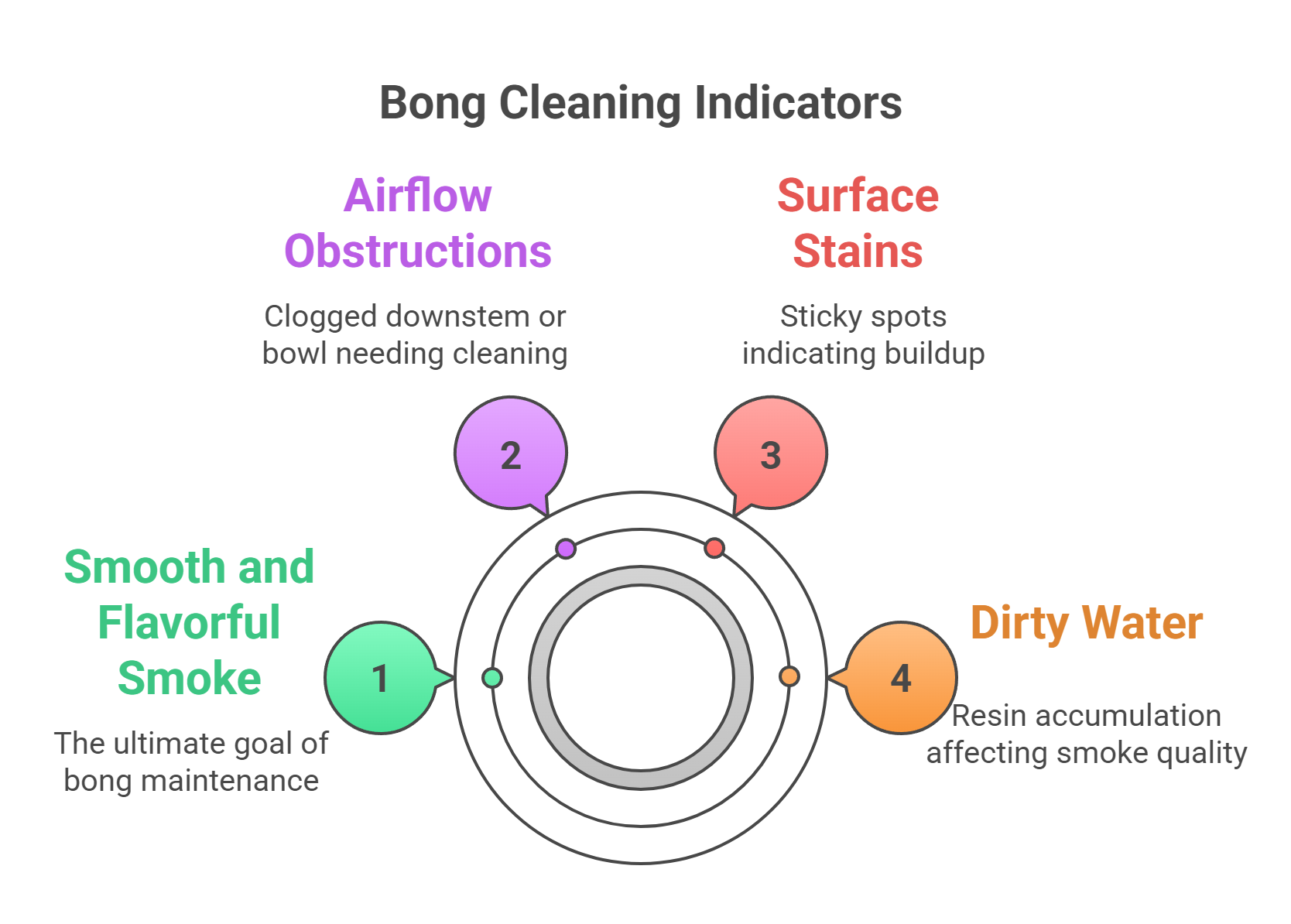
Knowing when to clean your bong can be as simple as paying attention to a few telltale signs:
-
Dirty bong water accumulates sticky resin and dirty resin, leading to a harsher smoke quality that is less enjoyable.
-
Sticky spots or dark stains on your bong’s surface, indicating it’s time for a cleaning session to tackle the buildup.
-
Obstructions in airflow, often indicating that the downstem or bowl is clogged and needs to be cleaned.
Letting your bong get too dirty not only affects your smoking experience but also makes the cleaning process harder and more unpleasant over time. Regular inspections and cleanings will help you maintain a clean and functional bong, ensuring each hit is smooth and flavorful.
Health Risks Associated with Dirty Bongs
A dirty bong is not just an eyesore; it can pose serious health risks. Regular cleaning is essential to prevent health issues caused by bacteria and mold that can develop in dirty water.
Bacteria and mold can thrive in dirty bong water, making cleanliness important for health and taste. Contaminated bong water can result in the inhalation of harmful contaminants, leading to serious respiratory conditions.
Mold thrives in warm, moist environments, making your bong an ideal breeding ground for these harmful organisms.
In extreme cases, using a dirty bong has been linked to severe lung infections, such as necrotizing pneumonia caused by pseudomonas aeruginosa.
Marijuana users who smoke through bongs are at increased risk of developing various lung disorders, including infections and airflow obstruction, affecting their respiratory system.
A clean bong significantly reduces these health risks, ensuring a safer smoking experience.
Choosing the Right Cleaning Supplies
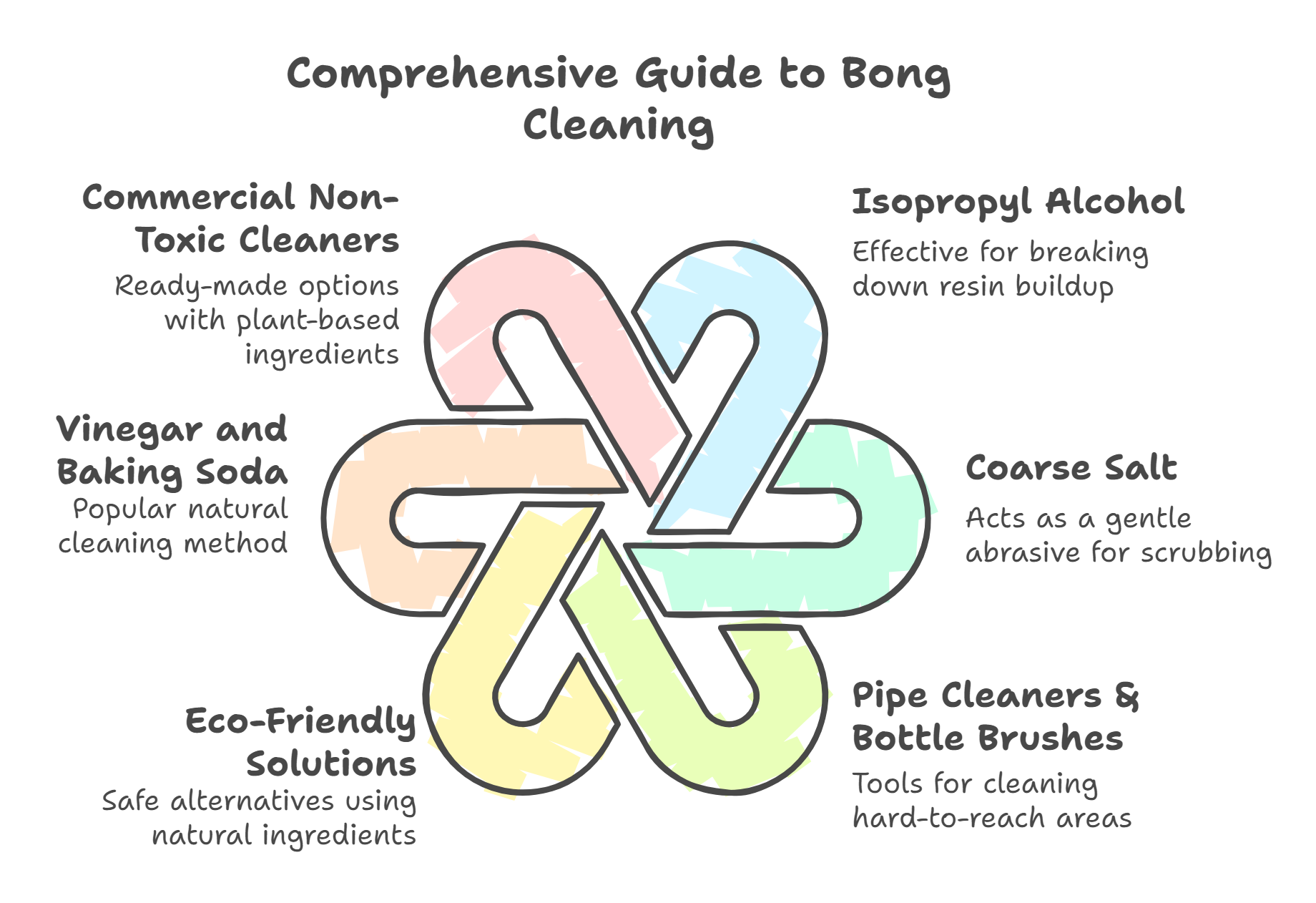
Selecting the right cleaning supplies is just as important for keeping your glass bong in pristine condition and ensuring a safe smoking experience.
For most glass bongs, isopropyl alcohol and coarse salt are the go-to cleaning agents. Isopropyl alcohol effectively breaks down sticky resin buildup, while coarse salt acts as a gentle abrasive to scrub away stubborn residue.
For those hard-to-reach areas, pipe cleaners and bottle brushes are invaluable tools, allowing you to gently scrub every nook and cranny of your bong.
Eco-Friendly Cleaning Options
For those looking to maintain their bong without harsh chemicals, eco-friendly cleaning solutions offer a safe and effective alternative that is gentle on both your glass and the environment. Natural ingredients like vinegar, baking soda, and lemon juice can break down resin and grime while avoiding toxic residues.
Vinegar and Baking Soda Solution
One of the most popular natural cleaning methods combines the acidity of white vinegar with the gentle abrasiveness of baking soda. Here’s how to use it effectively:
1. Mix equal parts white vinegar and water in a container or directly into the bong.
2. Add about 2 tablespoons of baking soda (the mixture will fizz) to loosen stubborn residue.
3. Pour the solution into your bong, plugging all openings to prevent leaks.
4. Shake the bong gently for several minutes, allowing the fizzing action to scrub internal surfaces.
5. Let it soak for around 30 minutes for deep cleaning.
6. Rinse thoroughly with warm water until no vinegar or baking soda remains.
Commercial Non-Toxic Cleaners
If you prefer ready-made options, several brands specialize in environmentally friendly bong cleaners that avoid harsh chemicals. They typically use plant-based or mineral ingredients that break down resin effectively without damaging your bong or leaving harmful residues. Look for labels specifying “biodegradable,” “non-toxic,” and free from ammonia or bleach.
Bong Cleaning Methods
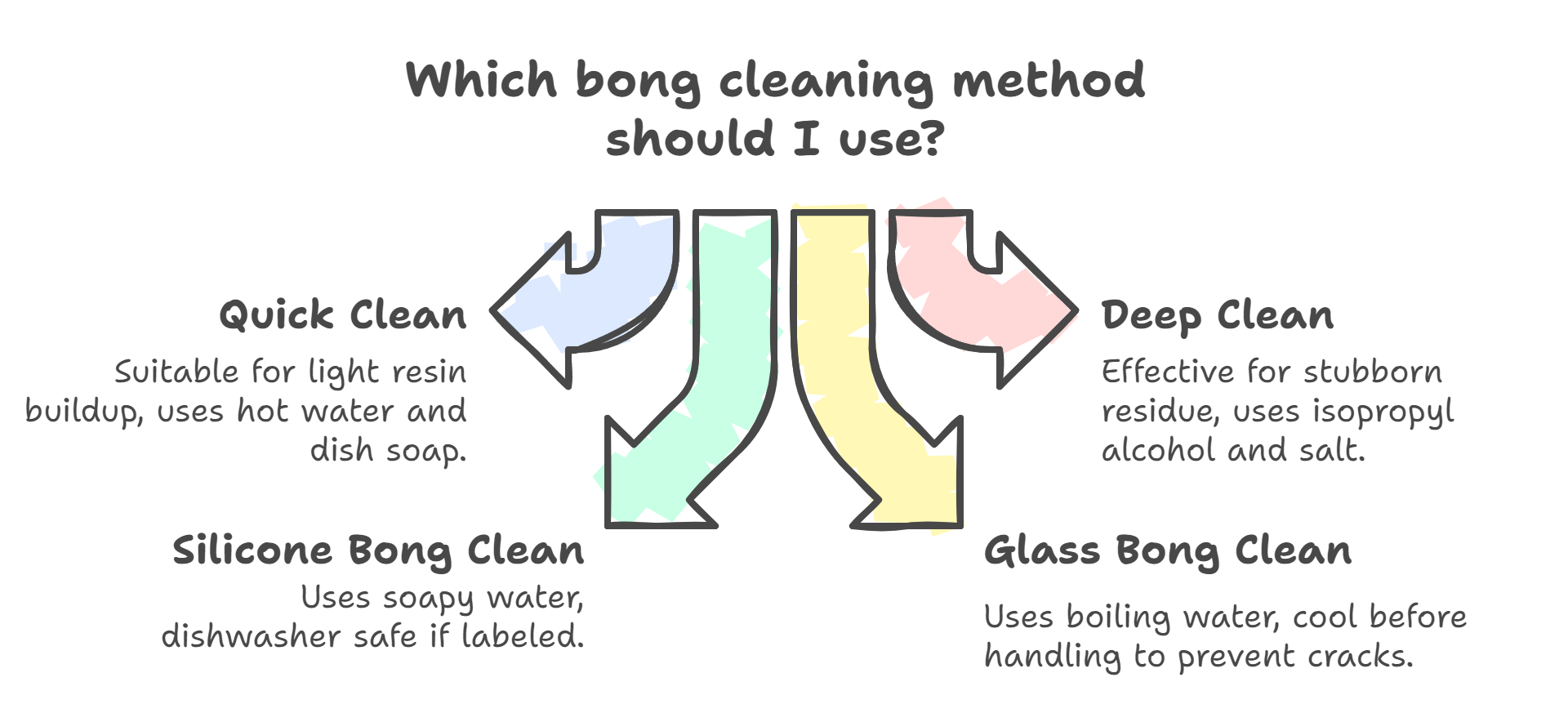
There are several effective bong cleaning methods to suit different levels of buildup and types of bongs. For a quick clean, simply soak your bong in hot water with a generous amount of dish soap. This helps loosen light resin buildup and makes it easier to rinse away debris.
For a deeper clean, especially if you’re dealing with stubborn residue or dirty resin, a mixture of isopropyl alcohol and coarse salt is highly effective. Pour the solution into your glass bong, cover the openings, and shake vigorously to dislodge resin from the water chamber and other surfaces.
If you have a silicone bong, opt for soapy water and avoid harsh chemicals. Silicone bongs can also be placed in the dishwasher if they are labeled as dishwasher safe. However, always ensure they are rinsed thoroughly after use to remove any soap or residue. For glass bongs, boiling water can be used for a thorough clean, but always allow the glass to cool before handling to prevent cracks.
Step-by-Step Cleaning Guide
-
Disassemble Your Bong: Carefully remove all detachable parts, including the bowl and downstem. This allows thorough cleaning of each component separately and ensures no hidden resin is left behind.
-
Rinse with Warm Water: Rinse each piece with warm water to loosen up loose debris and resin. Avoid boiling water as it can damage some materials.
-
Add Cleaning Solution: Pour about 1 cup of isopropyl alcohol (ideally 90% or higher) into the chamber. Add 2-3 tablespoons of coarse salt, which acts as an abrasive to scrub the resin off the glass's inner surfaces. For removable parts, place them in a sealable bag with the same solution.
-
Shake Vigorously and Soak: Cover the openings with your hands, rubber stoppers, or caps and shake vigorously for 1-2 minutes to dislodge resin buildup. Let your bowl and downstem soak in the solution for 15-30 minutes to loosen stubborn residue.
-
Scrub Stubborn Areas: Use pipe cleaners, cotton swabs, or a cleaning brush designed for bongs to clean hard-to-reach areas such as inside the downstem or percolators. Repeat soaking or shaking if necessary.
-
Rinse Thoroughly: Rinse all parts thoroughly with warm water until no alcohol, salt, or residue remains. This prevents lingering tastes or irritation during use.
-
Dry Completely and Reassemble: Allow all pieces to air dry fully before reassembling your bong.
Following these detailed steps regularly will keep your bong clean, improve smoke flavor, and extend the device’s lifespan.
Common Bong Cleaning Mistakes
When it comes to bong cleaning, there are a few common mistakes that can compromise both your bong and your health. One of the biggest errors is using harsh cleaning agents like bleach or ammonia, which can damage your bong and leave behind toxic residues. Acrylic bongs, in particular, should be cleaned gently with warm soapy water and a brush to avoid scratches or damage. Another frequent mistake is not rinsing your bong thoroughly after cleaning, which can result in lingering soap scum or cleaning solution that affects the taste and safety of your smoke.
Another frequent mistake is not rinsing your bong thoroughly after cleaning, which can result in lingering soap scum or cleaning solution that affects the taste and safety of your smoke.
Failing to dry your bong completely after cleaning is another pitfall, as any remaining moisture can create a breeding ground for bacteria and mold.
Additionally, using abrasive materials such as rough scrubbers or steel wool can scratch the surface of your bong, making it more susceptible to resin buildup and harder to clean in the future.
Troubleshooting Cleaning Issues
Even with regular maintenance, some cleaning challenges can arise. The table below outlines common problems users face when cleaning their bongs, explains typical causes, and offers practical step-by-step solutions to get your bong back to pristine condition.
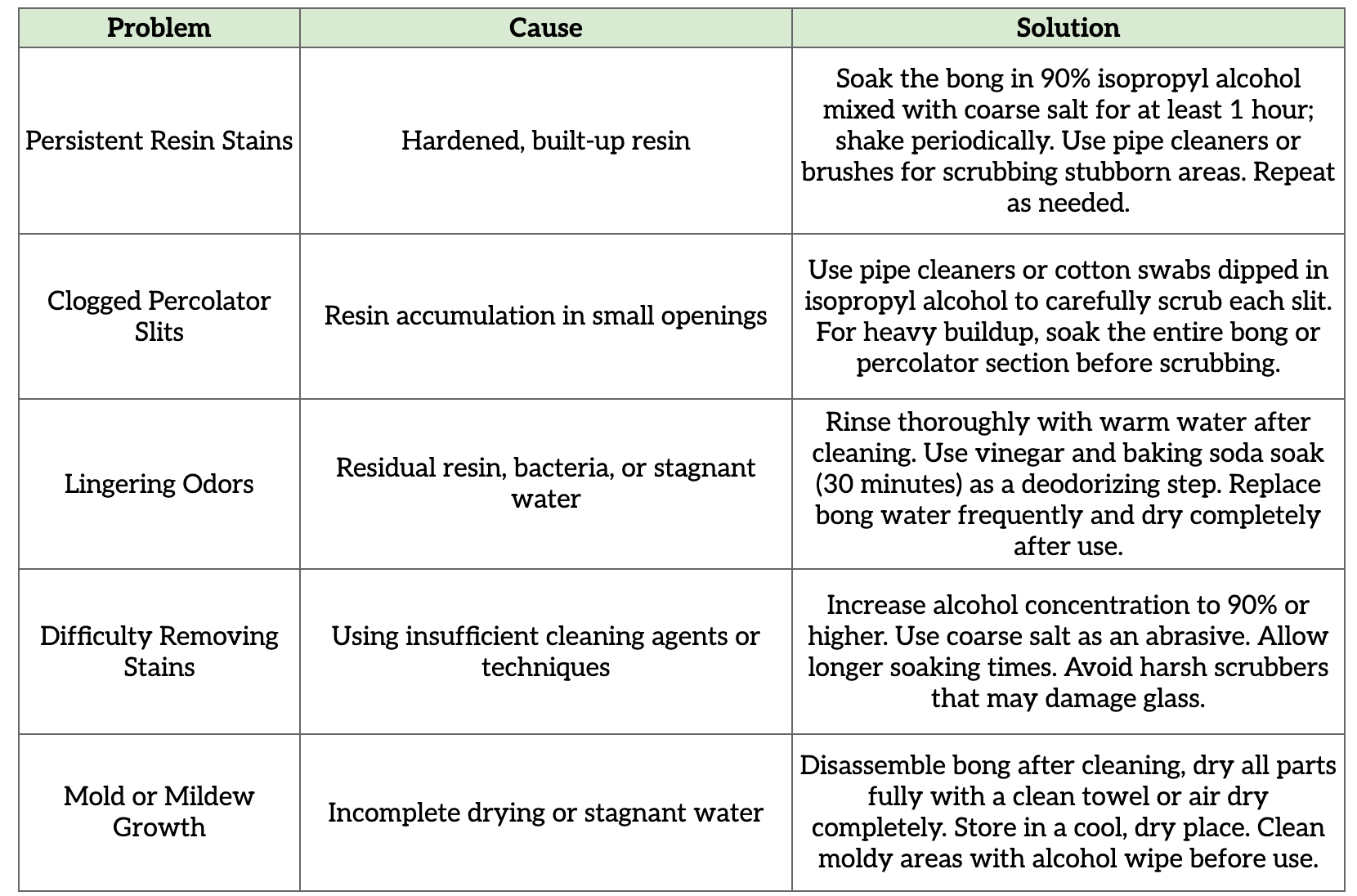
To avoid these mistakes, always use gentle cleaning agents, rinse your bong thoroughly with warm water, and dry it completely with a clean towel or allow it to air dry. Regular cleaning and proper storage will help prevent dirty resin buildup and keep your bong in top condition for every session.
Bong Cleaning Safety Precautions
Safety should always be a priority when cleaning your bong. Start by wearing rubber gloves to protect your hands from cleaning agents like isopropyl alcohol, and consider using a mask if you’re sensitive to fumes. Always clean your bong in a well-ventilated area to avoid inhaling any potentially harmful vapors.
If you’re using boiling water as part of your cleaning process, be cautious to avoid burns and never use boiling water near open flames or sparks, especially when working with alcohol-based cleaning solutions.
After cleaning, make sure your bong is completely dry before storing it to prevent water spots, mineral deposits, and the growth of harmful contaminants.
Proper storage is also key. Keep your bong in a cool, dry place to maintain its cleanliness and ensure it’s ready for your next smoking session.
Daily Maintenance Tips for Your Bong
Daily maintenance is key to keeping your bong in top condition. Aim to change your bong water after each session for optimal hygiene. Begin the bong cleaning process by emptying and rinsing your bong thoroughly with warm water and hot water.
After rinsing, use a paper towel to remove excess moisture before air drying. This step helps eliminate loose ashes and herb particles, preventing them from building up over time. Remember to water your bong regularly to maintain its cleanliness.
Using filtered water in your bong can also minimize residue buildup. Cold water in your bong can also cool the smoke and provide a smoother, more refreshing experience.
Adding a small amount of lemon juice to the bong water can also help keep the glass cleaner due to its acidic properties. Avoid overfilling your bong to reduce the chance of water leaving residue at different levels within the chamber.
Proper Storage and Preventing Mold Growth
Proper storage is crucial in preventing mold growth and maintaining your bong’s cleanliness. To ensure this:
-
Empty the water from your bong daily to prevent stagnation and reduce unwanted odors.
-
Inspect your bong regularly for signs of mold or mildew, such as discoloration, unusual odors, and visible patches.
-
If you discover mold growth, take immediate action and clean your bong thoroughly.
Always make sure you have a completely dry bong before storage, as any residual moisture can promote mold and mildew growth. Using a protective case or bag designed for bongs can also help protect it from dust and contaminants.
Emptying and Drying Your Bong Completely
Emptying and drying your bong after each use is important for preventing mold growth. Disassemble your bong, rinse the components, and allow them to air dry completely to ensure thorough drying. This practice prevents the buildup of moisture that can lead to mold and mildew.
This practice prevents the buildup of moisture that can lead to mold and mildew.
Storing Your Bong Properly
When it comes to storing your bong, avoid places with high moisture levels, such as bathrooms or basements. Store your bong in an upright position to reduce pressure on delicate parts and prevent breakage.
Proper storage not only extends the life of your bong but also ensures it remains clean and ready for use.
Combatting Foul Odors from Dirty Bong Water
Foul odors from dirty bong water can be a major turnoff. The best way to combat these odors is to change the water frequently. Fresh water enhances the flavor of hits, allowing smokers to fully appreciate the unique characteristics of their chosen strain.
Tobacco residue, ash, and bacteria contribute to foul odors, creating an ideal breeding ground for bacteria. Adding lemon juice or essential oils to your bong water or using soapy water can improve its scent and improve your smoking experience.
Changes in smell or taste indicate that residue is affecting the quality of the smoke. Regular cleaning and water changes will help you maintain a fresh-smelling bong.
Summary
Maintaining a clean bong goes beyond aesthetics. It's more about ensuring a safe and enjoyable smoking experience. These cleaning and maintenance practices also apply to any water pipe, helping you enjoy a cleaner, more modern alternative to traditional bongs and ensuring a safe experience regardless of the device.
Incorporate these cleaning practices into your routine, and you’ll find that a little effort goes a long way in preserving the quality of your smoking sessions.
Join thousands of other smokers who experience fresher, smoother sessions all the time. Switch to Mary Go Round Bong Bowl today.
Frequently Asked Questions
How often should you change your bong water?
You should change your bong water after every smoking session to ensure optimal hygiene and performance.
What are the signs that your bong needs cleaning?
If you notice discolored water, sticky resin build-up, a slimy texture, or an unpleasant taste, it's time to clean your bong.
What are the health risks associated with using a dirty bong?
Using a dirty bong significantly increases the risk of respiratory infections and allergic reactions. Maintaining cleanliness helps you protect your lung health and overall well-being.
How often should moderate users deep clean their bong?
Moderate users should deep clean their bong every 1-2 weeks to ensure optimal performance and hygiene.
What is the best way to store a bong to prevent mold growth?
To prevent mold growth, always make sure you store your bong in a cool, dry place, away from direct sunlight and humidity, ensuring it is completely dry before storage.

